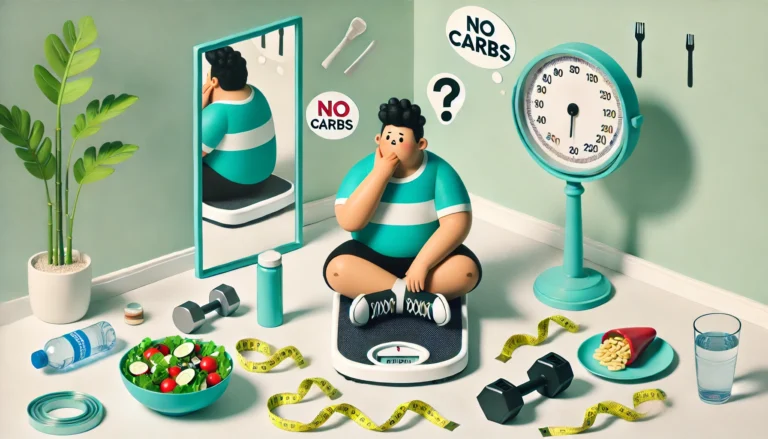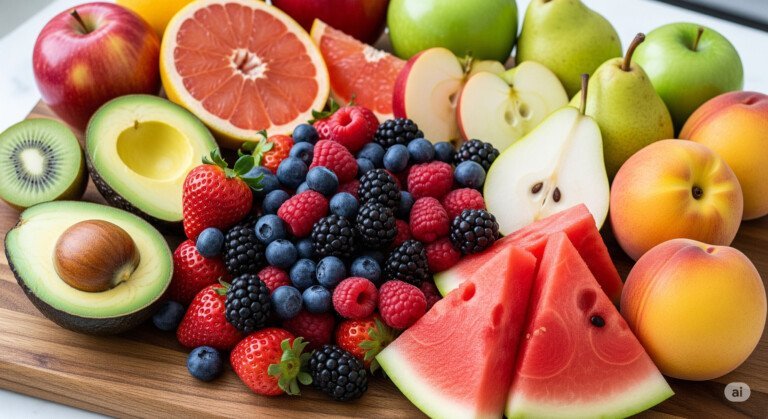Sustainable Weight Loss: Boost Diet, Exercise & Mindset
1. The Real Meaning of Sustainable Weight Loss
When most people think about losing weight, their minds immediately jump to diets — often the latest trend splashed across magazines, Instagram reels, or YouTube fitness channels. Words like “detox,” “cleanse,” or “30-day shred” sound promising because they offer quick results. But here’s the uncomfortable truth: these approaches rarely last. The weight lost often creeps back, sometimes with interest, leaving you more frustrated than before.
Thank you for reading this post, don't forget to subscribe!This is exactly where the concept of sustainable weight loss comes in. At its core, sustainable weight loss isn’t about chasing a magic number on the scale or following rules you hate until you finally “break.” Instead, it’s about creating a healthy lifestyle you can live with — one that helps you feel stronger, lighter, and more energetic not just for a month, but for years to come.
Think of it like this: if weight loss is a journey, fad diets are like trying to sprint a marathon. You might make progress for a short distance, but you’ll quickly run out of steam. Sustainable weight loss is the steady pace you can keep up mile after mile — a pace that doesn’t burn you out, but still gets you to the finish line.
So what does sustainable weight loss actually mean? It means:
- Balanced eating, not restriction. You fuel your body with whole, nutrient-rich foods while still enjoying your favorite treats in moderation.
- Consistency over perfection. Instead of all-or-nothing rules, you focus on habits you can stick to — even when life gets messy.
- A lifestyle shift, not a temporary fix. You’re not “on a diet.” You’re learning how to live in a way that supports your health naturally.
- Mindset first. Weight loss isn’t just physical; it’s also emotional. Building patience, self-compassion, and resilience is just as important as calories and workouts.
The beauty of this approach is that it respects both your goals and your humanity. You don’t have to give up pizza nights with friends, skip birthday cake, or live in the gym to see progress. Instead, you learn to create balance that works in the real world. That’s what makes it sustainable.
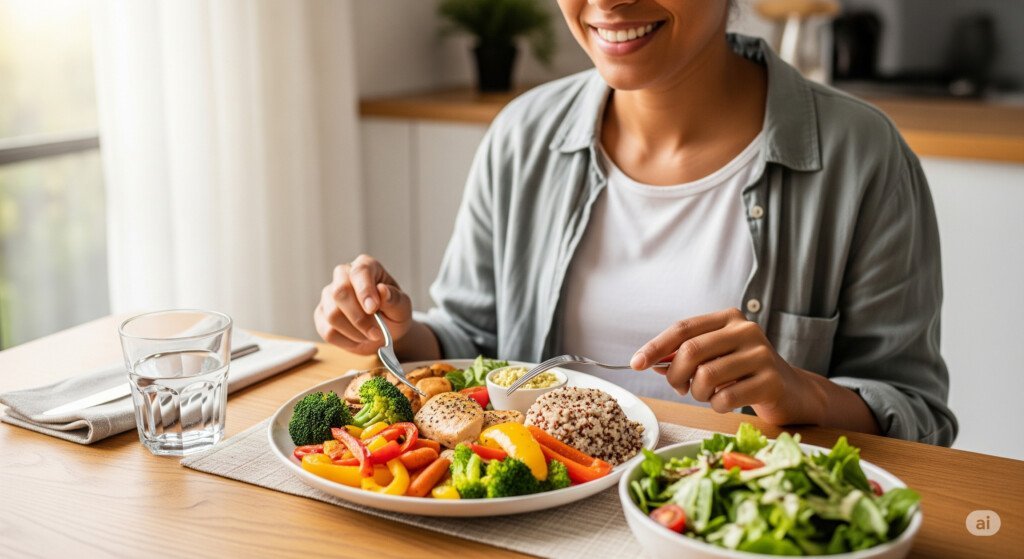

Why Most People Fail With Quick Fixes
If quick diets worked, we’d all be walking around at our ideal weight right now. The truth is, the weight-loss industry thrives on repeat customers — people who jump from one trend to the next, always chasing results but never holding onto them. That cycle of excitement, hope, disappointment, and guilt is what keeps the market booming.
The sad part? It’s not because people are weak, lazy, or undisciplined. It’s because the quick-fix approach is designed to fail.
1. They Rely on Restriction, Not Nourishment
Imagine being told you can’t eat carbs ever again. For a week, maybe two, you stick with it. You turn down bread at dinner, push away dessert, and smile politely while sipping black coffee at brunch. But inside, the cravings are building like a storm. Then one stressful day at work hits, and suddenly a single slice of pizza turns into three, followed by ice cream because “you’ve already blown it.”
This isn’t lack of willpower — it’s biology. Your body doesn’t respond well to extremes. Crash diets that slash calories or eliminate entire food groups put your body into survival mode, slowing metabolism and increasing cravings. In the long run, this makes weight loss harder, not easier.


2. They Focus on Speed, Not Sustainability
Losing ten pounds in ten days sounds amazing on paper, but let’s look closer. Most of that initial drop is water weight and glycogen (stored carbohydrates), not fat. When you return to normal eating, the weight bounces back almost immediately. This “yo-yo effect” not only crushes your motivation but also damages your trust in yourself.
Sustainable weight loss works differently. Instead of celebrating how much you lost in a week, you focus on steady progress over months. You don’t just look better; you feel better, sleep better, and actually enjoy the process.
3. They Ignore the Role of Lifestyle
Quick-fix programs rarely prepare you for real life. What happens when you go on vacation? Or when your kid’s birthday party includes cake and soda? Or when stress makes you crave comfort food? If your entire weight loss plan depends on drinking shakes or following a rigid chart, you’re one life event away from failure.
That’s why sustainable weight loss emphasizes flexibility. Instead of rigid rules, you learn adaptable habits. You figure out how to enjoy a slice of cake without guilt, how to balance a big dinner with a lighter lunch, and how to bounce back after a stressful week without throwing everything away.
4. They Overlook Mindset
The biggest reason quick fixes fail isn’t physical at all — it’s mental. Many people believe weight loss is a battle of willpower, but the truth is, willpower alone won’t carry you far. When you rely only on motivation and strict rules, you eventually burn out.
Sustainable weight loss takes a different path. It’s rooted in mindset shifts — learning to see food as fuel, exercise as a gift, and progress as a journey instead of a finish line. That shift is what makes results stick.
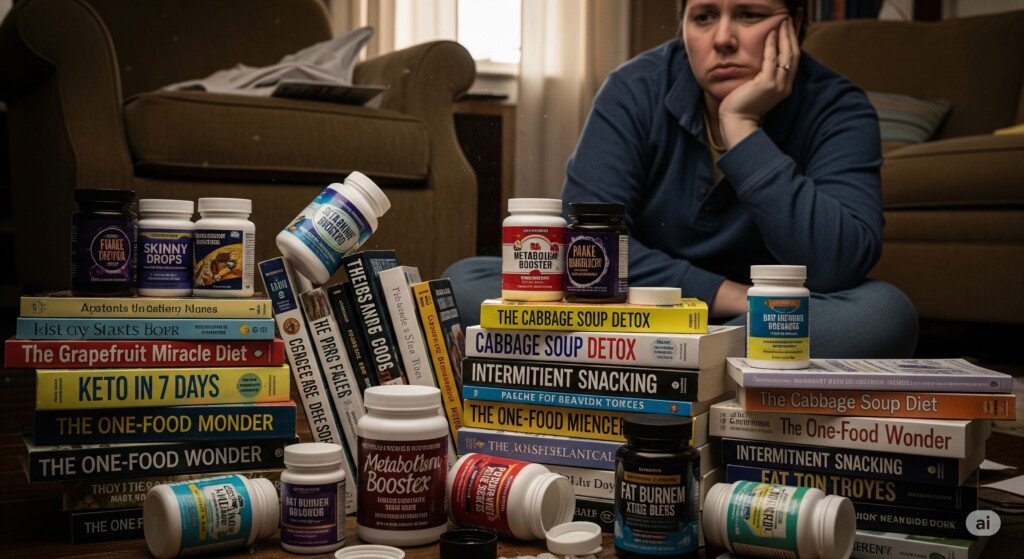

The Emotional Toll of Quick Fixes
Beyond the science, let’s talk about the emotional side. If you’ve ever tried and “failed” at a diet, you know the heavy mix of guilt and frustration that follows. You might even tell yourself, “Maybe I’m just not disciplined enough.”
But here’s the truth: it’s not your fault. Quick-fix diets set you up for failure from the start. They’re designed to be temporary, to give you just enough results to believe in them — and just enough rebound to make you buy in again.
That endless loop creates shame and discouragement, which makes starting over even harder. Many people eventually stop trying altogether, not because they can’t succeed, but because they’ve been sold the wrong strategy over and over again.
Breaking free from this cycle begins with understanding that lasting weight loss doesn’t come from extremes — it comes from balance.


The Promise of a Sustainable Approach
At this point, you might be wondering: if quick fixes don’t work, then what does? The answer isn’t flashy or glamorous, but it is powerful: a balanced combination of diet, exercise, and mindset. When these three pieces work together, they create the foundation for long-term success.
Unlike crash diets, this isn’t about overhauling your entire life overnight. It’s about small, consistent changes that stack up over time. The promise of sustainable weight loss is simple but profound — not only will you lose the weight, but you’ll also keep it off while building a healthier, more enjoyable lifestyle.
Let’s break down the three pillars.
1. Diet: Fueling Your Body, Not Punishing It
Food is often seen as the enemy in weight loss, but the truth is, food is your greatest ally. Sustainable weight loss doesn’t mean eating less — it means eating smarter.
- Whole foods over processed foods. Think fresh vegetables, fruits, lean proteins, whole grains, and healthy fats. These provide nutrients that keep your body energized and satisfied.
- Portion awareness, not obsession. Instead of weighing every bite, you learn to listen to your body’s hunger and fullness signals.
- Flexibility. Yes, you can enjoy pizza, chocolate, or wine — the key is moderation, not elimination.
This way of eating isn’t a temporary diet; it’s a balanced approach you can maintain for life. You’re not surviving on lettuce and lemon water. You’re nourishing your body in a way that feels good and fits your lifestyle.
2. Exercise: Movement That Motivates
Many people think exercise has to be grueling workouts at the gym, but that’s another quick-fix mindset. Sustainable exercise is about finding activities you actually enjoy — because what you enjoy, you’ll keep doing.
- If you love dancing, Zumba or hip-hop classes can be your cardio.
- If you enjoy the outdoors, hiking or cycling can replace hours on a treadmill.
- If you like structure, strength training helps build lean muscle and boost metabolism.
The point isn’t to punish your body for eating — it’s to celebrate what your body can do. Movement should be a reward, not a chore. When exercise becomes part of your identity, not just a means to an end, you unlock consistency without constant struggle.


3. Mindset: The Game-Changer
Here’s where the magic really happens. You can follow the best meal plan and the most effective workout routine, but if your mindset is locked in a cycle of guilt, perfectionism, or “all-or-nothing” thinking, your progress won’t last.
Sustainable weight loss requires a mindset shift:
- Progress over perfection. Missing a workout or eating dessert isn’t failure — it’s part of real life.
- Self-compassion over self-criticism. You can’t hate yourself into a body you love. Treating yourself with kindness fuels resilience.
- Patience over urgency. Real results take time. The slower, steady path feels frustrating in the moment but pays off for decades.
When you shift your mindset, everything else becomes easier. Food no longer controls you, exercise feels empowering, and setbacks become learning opportunities rather than reasons to quit.
Why This Works When Nothing Else Does
The beauty of combining diet, exercise, and mindset is that they reinforce one another. When you eat well, you have more energy to exercise. When you exercise, you feel more motivated to eat well. And when your mindset supports your efforts, you keep going even when progress feels slow.
This approach doesn’t promise you’ll lose ten pounds in a week. Instead, it promises something far more valuable: you’ll build a lifestyle that allows you to reach and maintain your healthy weight without giving up the joy of living.


2. Why Sustainable Weight Loss Matters
When people talk about losing weight, the conversation often revolves around appearance — fitting into smaller clothes, looking good in photos, or reaching a number on the scale. While these goals are completely valid, they barely scratch the surface of why sustainable weight loss truly matters. Beyond the mirror and the compliments, there are deeper, life-changing benefits tied to your health, your energy, and your long-term quality of life.
Sustainable weight loss isn’t just about looking better — it’s about living better. And the difference between chasing quick results and focusing on the bigger picture could mean the difference between a temporary change and a lifelong transformation.
Long-Term Health Benefits of Sustainable Weight Loss
The human body is resilient, but it thrives when it’s in balance. Carrying excess weight for long periods places stress on almost every system in your body — from your heart and joints to your hormones and immune system. Choosing a sustainable approach to weight loss allows your body the time and space it needs to heal, adapt, and improve.
Here are some of the long-term benefits:
1. Better Heart Health
Obesity is one of the strongest risk factors for cardiovascular disease. Extra weight increases blood pressure, raises cholesterol, and makes your heart work harder with every beat.
When you pursue sustainable weight loss, even modest changes have a big impact. Research shows that losing just 5–10% of body weight can significantly lower blood pressure and improve cholesterol levels. Unlike rapid crash diets that may stress the heart, steady weight loss strengthens it. Over time, you’re not just lighter on the scale — your heart is literally healthier and more resilient.


2. Reduced Risk of Type 2 Diabetes
Carrying excess fat, especially around the belly, makes the body resistant to insulin. This resistance leads to higher blood sugar levels and eventually type 2 diabetes.
Quick-fix diets might temporarily lower glucose, but because they aren’t sustainable, blood sugar often spikes back when old habits return. In contrast, adopting balanced eating patterns — like including fiber-rich foods, lean proteins, and healthy fats — not only helps shed pounds slowly but also stabilizes blood sugar long term. That’s why sustainable approaches are often recommended by doctors as the first line of defense against diabetes.
3. More Energy and Vitality
One of the most underrated benefits of sustainable weight loss is the energy boost it creates. When your body is fueled properly and not constantly swinging between starvation and bingeing, you feel lighter, sharper, and more capable in daily life.
Think of how different your mornings would feel if you woke up refreshed, had steady energy through the afternoon, and didn’t crash after lunch. That’s the kind of vitality sustainable habits create. Instead of living on caffeine and sugar spikes, you start to thrive on natural energy.
4. Joint and Mobility Health
Excess weight doesn’t just affect your internal organs — it also strains your joints. Knees, hips, and lower back bear the brunt, leading to pain, stiffness, and even arthritis over time.
With gradual, sustainable weight loss, pressure on your joints eases naturally. Losing just 10 pounds can reduce up to 40 pounds of force on your knees with every step. That means fewer aches, more freedom of movement, and the ability to stay active as you age.
5. Emotional and Mental Health
While often overlooked, mental health is directly tied to how we approach weight loss. Quick fixes create cycles of guilt, shame, and disappointment. Sustainable approaches, however, build confidence, patience, and self-trust.
As you create lasting habits, you prove to yourself that you can stick with change. That self-belief carries over into other areas of life — from career to relationships — creating a ripple effect of positive change.
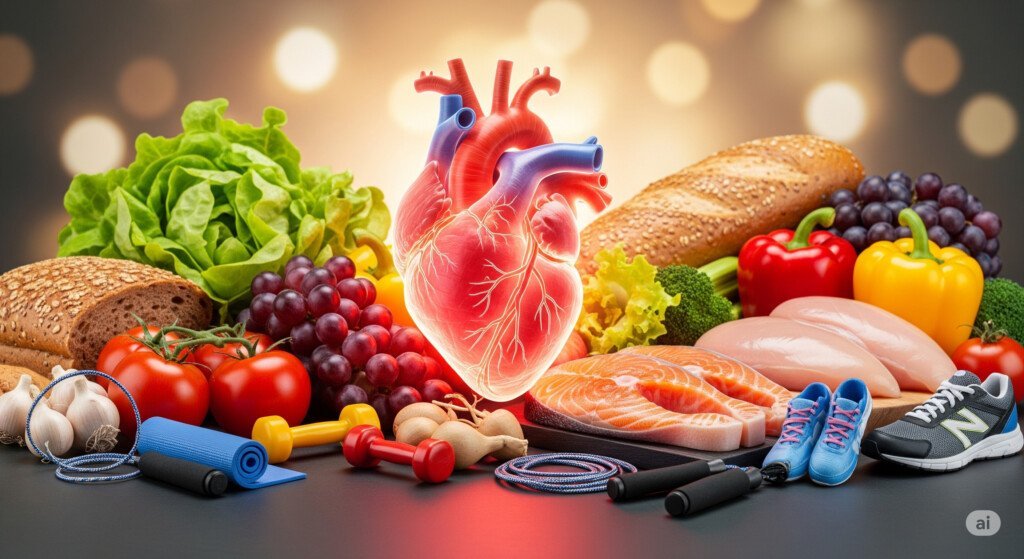

Quick Weight Loss vs. Sustainable Weight Loss
It’s easy to get lured in by quick fixes. They promise results in days or weeks, while sustainable approaches ask for patience and consistency. But let’s break down the differences to see why the long game is worth it.
| Aspect | Quick Weight Loss | Sustainable Weight Loss |
|---|---|---|
| Speed | Rapid — lose pounds in days or weeks | Steady — 1–2 pounds per week |
| Method | Extreme restriction, supplements, or fad rules | Balanced eating, enjoyable movement, mindset work |
| Result | Temporary drop, often water weight | Long-lasting fat loss, improved health |
| Impact on Body | Slowed metabolism, nutrient deficiencies, rebound gain | Improved metabolism, steady energy, strong immune system |
| Impact on Mind | Stress, guilt, “all-or-nothing” thinking | Confidence, patience, self-trust |
| Sustainability | Impossible long term | Realistic for life |
The comparison makes it clear: one path leaves you stuck in a cycle of hope and frustration, while the other builds health that lasts.
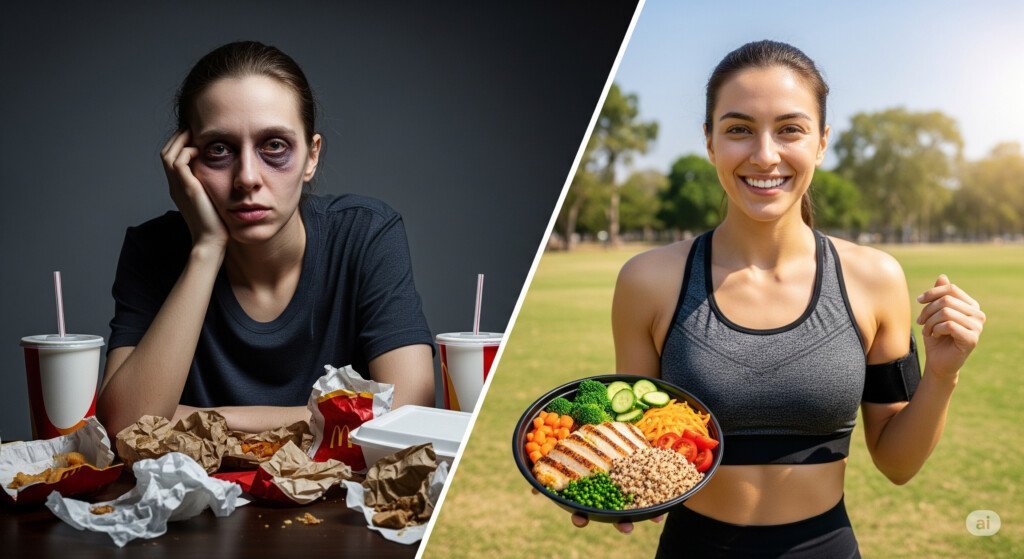

Healthy Weight Loss Tips for Lasting Results
If you’re wondering where to start, here are some healthy weight loss tips that fit into the sustainable approach:
- Aim for slow progress. Losing 1–2 pounds per week might sound slow, but it adds up to 50–100 pounds a year. That’s the kind of change that sticks.
- Focus on whole foods. Fill your plate with colorful vegetables, lean protein, and high-fiber carbs. These foods keep you full and energized.
- Don’t ban your favorite treats. Deprivation fuels bingeing. Instead, practice moderation — enjoy dessert without guilt.
- Move in ways you enjoy. Exercise doesn’t have to be punishment. Dance, swim, hike, lift weights — choose what excites you.
- Prioritize sleep. Lack of rest disrupts hunger hormones and increases cravings. Quality sleep is as important as diet and exercise.
- Manage stress. High stress triggers emotional eating. Practices like meditation, journaling, or deep breathing can keep you balanced.
- Track habits, not just weight. Celebrate wins like drinking more water, cooking at home, or completing workouts. These habits fuel long-term success.
These tips might sound simple, but that’s the point — they’re practical and realistic. Unlike restrictive crash diets, they’re tools you can keep using for the rest of your life.
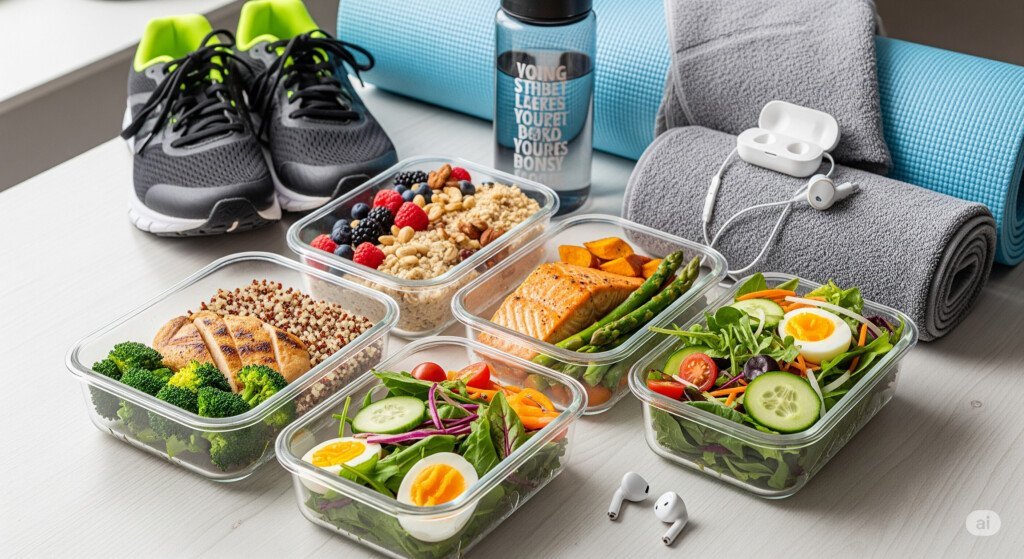

3. The Core Principles of Sustainable Weight Loss
If you’ve ever asked yourself, “How do I finally lose weight and keep it off?”, you’re not alone. Millions of people struggle not because they’re lazy or unmotivated, but because they’re missing the bigger picture. Sustainable weight loss isn’t about quick tricks — it’s about understanding and applying a few timeless principles that make the process both safe and effective.
At the heart of every successful transformation are three interconnected pillars: nutrition, movement, and mindset. These create the balance your body needs. And when you combine that balance with a safe calorie deficit, you unlock the ability to reach your goals without extreme sacrifices.
If you’ve been searching for how to lose weight naturally, this is where it begins.
1. Nutrition — Fueling Your Body the Right Way
Nutrition is the foundation of sustainable weight loss. But the problem is, the diet world has made food confusing. One year carbs are the enemy, the next year it’s fat, then sugar, then something else. No wonder most people feel lost.
The truth is simple: food isn’t your enemy, it’s your fuel. Sustainable nutrition is about balance, not restriction.
Key Practices for Nutrition Balance:
- Whole Foods First
Focus on eating foods as close to their natural state as possible. Vegetables, fruits, lean proteins, whole grains, and healthy fats should form the core of your diet. These foods not only provide essential vitamins and minerals but also keep you full longer. - Protein as a Priority
Protein is your ally in fat loss. It preserves muscle mass, boosts metabolism slightly, and keeps hunger in check. Including chicken, fish, beans, lentils, or tofu in meals is a game-changer. - Moderation, Not Elimination
Cutting out foods you love sets you up for failure. Sustainable weight loss allows flexibility. You can still enjoy pizza, chocolate, or wine — just not every day, and not in large amounts. - Hydration
Many people mistake thirst for hunger. Drinking water regularly supports metabolism, digestion, and energy levels. A simple healthy weight loss tip: start meals with a glass of water.
By shifting your perspective from “dieting” to “fueling,” you start to see food differently — not as something to fear, but as a tool for health and vitality.
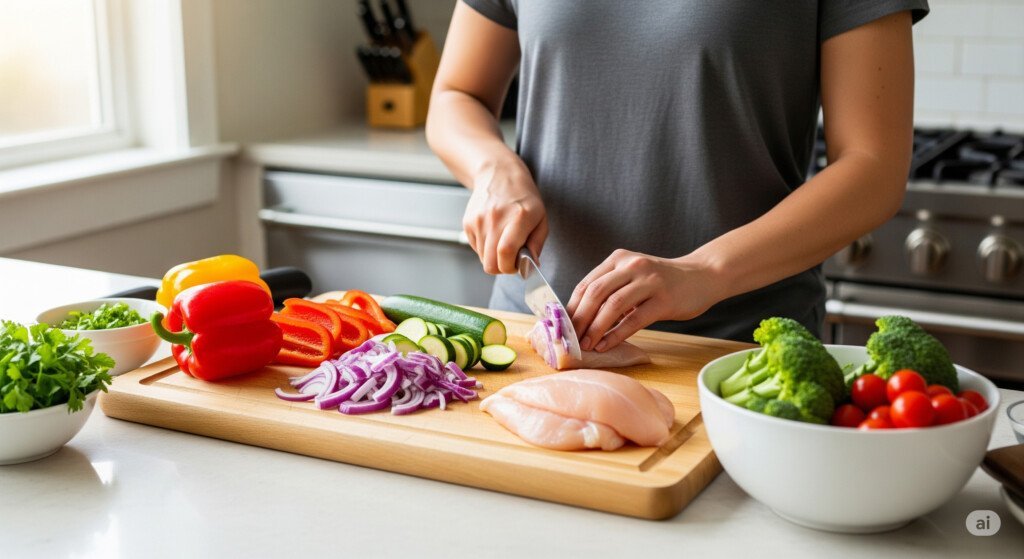

2. Movement — Making Exercise a Lifestyle
Exercise is often seen as punishment for eating, but that mindset is toxic. Movement should never be about guilt — it should be about empowerment. When you discover activities you enjoy, exercise becomes a natural part of life instead of a chore.
Why Movement Matters in Sustainable Weight Loss
- Burns calories in a healthy way → supports the calorie deficit without severe restriction.
- Builds lean muscle → more muscle means higher metabolism, even at rest.
- Improves mood & reduces stress → exercise releases endorphins that help fight emotional eating.
- Boosts longevity → regular activity supports heart health, bone strength, and overall vitality.
Types of Movement That Work Best
- Strength training: Builds lean muscle, improves body composition.
- Cardio: Supports heart health, burns calories, improves endurance.
- Flexibility & mobility work: Yoga, stretching, Pilates help prevent injury and improve recovery.
- Lifestyle movement: Walking, cycling to work, taking the stairs — small habits add up.
Remember, movement isn’t about perfection. A 20-minute walk after dinner is better than forcing yourself into a workout you hate. Consistency beats intensity.


3. Mindset — The Missing Piece
If nutrition and movement are the physical side of weight loss, mindset is the glue that holds it all together. Without the right mindset, even the best plan will crumble.
Key Mindset Shifts:
- Progress Over Perfection
Sustainable weight loss doesn’t demand perfect days. You’ll have slip-ups, celebrations, and off-weeks. The key is bouncing back without guilt. - Patience is Power
If you’ve gained weight over years, expecting to lose it in weeks is unrealistic. A natural, gradual approach is what sticks. - Self-Compassion
Beating yourself up doesn’t create change. Kindness and encouragement keep you moving forward. - Identity Shift
Instead of saying, “I’m on a diet,” shift to, “I’m someone who makes healthy choices.” Your habits flow from your identity.
This is why people who learn how to lose weight naturally don’t just transform their bodies — they transform their mindset, which is the true secret to lasting success.


4. Safe Calorie Deficit
The phrase “calorie deficit” scares people, but it’s simply the science of weight loss: you must burn more calories than you consume. The problem comes when people try to force a huge deficit by starving themselves.
That’s not sustainable — and it’s not safe.
How to Create a Healthy Calorie Deficit
- Small adjustments: Aim for a daily deficit of 300–500 calories. This leads to 1–2 pounds of fat loss per week.
- Add, don’t just subtract: Increase activity levels through walking or workouts instead of only cutting food.
- Nutrient density: Eat foods high in nutrients but lower in calories — like vegetables, lean proteins, and whole grains.
- Avoid extremes: Going below 1,200 calories for women or 1,500 for men can slow metabolism, cause nutrient deficiencies, and trigger bingeing.
When you create a deficit the right way, your body adapts smoothly. You lose fat steadily, keep muscle mass, and avoid the burnout of crash diets.


4. How to Lose Weight Naturally: The Practical Formula
When you put these principles together, the formula is straightforward:
- Eat mostly whole, nutrient-rich foods → but allow flexibility for foods you enjoy.
- Move your body regularly → mix strength, cardio, and fun activities.
- Maintain a safe calorie deficit → small daily changes add up.
- Adopt a positive, patient mindset → celebrate progress, not perfection.
That’s it. No magic pills, no extreme detoxes, no overnight promises. This is the essence of learning how to lose weight naturally — by creating a life where healthy habits feel normal, not forced.
1. The Role of Nutrition in Weight Loss
When people think about losing weight, the first thing that usually comes to mind is hitting the gym. Cardio, weight training, or high-intensity interval workouts often steal the spotlight. While exercise is incredibly important for overall health, the truth is this: nutrition plays a far greater role in sustainable weight loss than most realize. In fact, many experts estimate that successful weight management is 70–80% nutrition and 20–30% exercise. This doesn’t mean exercise is unimportant—it simply highlights that what we eat, how much we eat, and the quality of our food choices determine whether we lose, gain, or maintain weight.
So why exactly does nutrition matter so much? Let’s break it down.
Calories in vs. Calories Out — The Foundation
At its most basic level, weight loss comes down to energy balance: the calories you consume versus the calories you burn. If you consistently consume more calories than your body needs, you store the excess as fat. On the flip side, if you consistently consume fewer calories, your body taps into stored fat to make up the difference.
But here’s the catch: not all calories are created equal. A 500-calorie meal made of sugary pastries will impact your body very differently than a 500-calorie meal made of lean protein, whole grains, and vegetables. The second option provides steady energy, keeps you full, supports muscle maintenance, and stabilizes blood sugar. The first option causes a rapid spike in blood sugar, followed by a crash, leaving you hungry again within an hour.
This is why sustainable weight loss isn’t just about cutting calories—it’s about making nutrient-dense food choices that fuel your body instead of draining it.


Metabolism and Hormonal Balance
Another reason nutrition is central to weight loss lies in its effect on metabolism and hormones. What we eat influences the hormones that regulate hunger, satiety, and fat storage.
- Protein-rich foods (chicken, fish, tofu, beans) stimulate the release of peptide YY and GLP-1, hormones that reduce appetite.
- High-fiber foods (vegetables, fruits, legumes, whole grains) slow digestion, keeping you fuller for longer.
- Processed carbs and sugar, on the other hand, cause sharp insulin spikes. Elevated insulin not only promotes fat storage but also leads to energy crashes that increase cravings.
By choosing foods that regulate hormones naturally, you can reduce overeating without relying on willpower alone.
The 80/20 Reality — Why Exercise Alone Isn’t Enough
It’s common to see someone spend hours at the gym, then head to a drive-thru for a large meal, thinking they “earned it.” Unfortunately, this mindset backfires. For example:
- Running 30 minutes may burn around 300 calories.
- A single fast-food burger with fries can easily exceed 800 calories.
In other words, it takes much longer to burn calories than to consume them. Without nutritional awareness, exercise can only get you so far. That’s why people often say, “You can’t out-train a bad diet.”
Nutrition for Energy and Consistency
Sustainable weight loss isn’t just about reducing numbers on the scale—it’s about creating a lifestyle that feels doable long-term. When you fuel your body with whole foods, you gain more energy, sleep better, and recover faster from workouts. These benefits make it easier to stay consistent, which is the ultimate key to lasting results.
Compare this to fad diets or extreme restriction: sure, you may see quick weight loss, but fatigue, mood swings, and nutrient deficiencies make it impossible to stick with. Before long, most people rebound, often gaining back more weight than they lost.
Real-Life Example: A Tale of Two Lunches
Imagine two different people trying to lose weight.
- Person A grabs a pepperoni pizza slice and soda (about 600 calories, mostly refined carbs and unhealthy fats). They feel stuffed for a short while, then crash mid-afternoon and crave more sugar.
- Person B eats a grilled chicken salad with olive oil, quinoa, and a side of fruit (about 600 calories, but balanced with protein, fiber, and healthy fats). They feel satisfied, energized, and don’t need a sugar fix later.
Both meals had similar calorie counts, but the outcomes couldn’t be more different. This is the power of nutrition: the quality of calories matters just as much as the quantity.


Healthy Weight Loss Tips in Action
If you’re aiming for sustainable results, here are a few healthy weight loss tips backed by science:
- Prioritize protein at every meal to stay full and preserve lean muscle.
- Fill half your plate with vegetables—they’re low in calories but high in nutrients and fiber.
- Swap refined grains for whole grains like oats, quinoa, or brown rice to avoid blood sugar crashes.
- Plan balanced snacks—think apple with peanut butter, or Greek yogurt with berries—instead of chips or candy.
- Drink water before meals to improve hydration and reduce overeating.
These are small but powerful shifts that add up to big long-term changes.
Why Nutrition Creates the Foundation for Mindset & Movement
Finally, it’s important to note that nutrition doesn’t exist in isolation. When you eat better, you naturally feel better. That improved energy spills over into motivation for exercise and strengthens your mindset. On the flip side, poor nutrition drains willpower, making workouts and positive thinking much harder.
This is why most sustainable weight loss frameworks put nutrition first, followed by exercise and mindset. Think of nutrition as the foundation of a house: without it, the whole structure collapses, no matter how strong the other parts are.
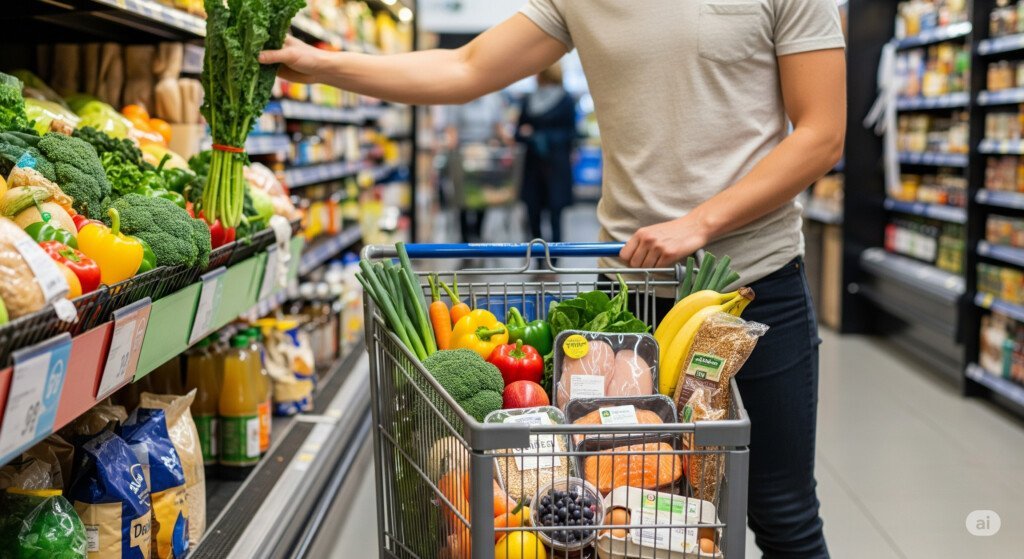

2. Whole Foods vs. Processed Foods
When it comes to building the best weight loss diet, one of the biggest choices you’ll face every day is simple: Do I eat whole foods or processed foods? This single decision can make or break your results.
Whole foods—like fruits, vegetables, lean proteins, nuts, seeds, and whole grains—are close to their natural state. They contain fiber, vitamins, minerals, and phytochemicals that support your health in countless ways. Processed foods, on the other hand, are often stripped of nutrients, loaded with added sugars, unhealthy fats, sodium, and artificial additives.
The contrast between these two categories is not just about health—it’s about how your body feels, how your metabolism functions, and ultimately, whether or not you can achieve sustainable weight loss.
Why Whole Foods Are Essential for Weight Loss
Whole foods are nutrient-dense, meaning they provide more nutrition for fewer calories. This is the exact formula you want for losing weight: maximum nourishment with minimal calorie load.
- Fiber and satiety: Whole foods like beans, apples, and oats contain soluble fiber that slows digestion and keeps you full. This reduces the urge to snack mindlessly between meals.
- Natural balance: Whole foods often come with the right balance of macronutrients. For example, salmon offers protein and omega-3 fats in one source; sweet potatoes provide complex carbs along with fiber and micronutrients.
- Stable energy levels: Because whole foods release energy slowly, you avoid blood sugar spikes and crashes that trigger cravings.
Think of whole foods as your ally—they not only help you shed weight but also build the foundation for lifelong health.
The Problem with Processed Foods
Processed foods aren’t inherently “evil.” Even freezing or lightly processing vegetables can preserve nutrients. The issue lies in ultra-processed foods—those designed for convenience and long shelf life but not your waistline.
- Calorie density without satiety: A bag of chips or cookies can contain hundreds of calories, but you’ll still feel hungry an hour later because they lack protein and fiber.
- Hidden sugars and fats: Even foods labeled “low-fat” or “healthy” can hide excess sugar or refined oils that stall fat loss.
- Addictive qualities: Processed foods are engineered to be hyper-palatable—meaning they light up reward centers in your brain, making it easy to overeat.
Studies consistently show that people who consume more ultra-processed foods have higher risks of obesity, diabetes, and heart disease. If your goal is weight loss, reducing these foods is one of the most effective strategies.


Practical Swaps: Processed to Whole
One of the best healthy weight loss tips is to make gradual swaps. You don’t have to overhaul your entire diet in one day—just start with simple changes.
- Breakfast: Swap sugary cereal for overnight oats topped with fruit and nuts.
- Lunch: Replace white bread sandwiches with whole-grain wraps filled with lean protein and veggies.
- Snacks: Trade chips or candy bars for air-popped popcorn, apple slices with almond butter, or Greek yogurt with berries.
- Dinner: Swap frozen pizza for homemade baked salmon with roasted vegetables and quinoa.
These swaps don’t just reduce calories—they dramatically improve the quality of calories you’re consuming.
Processed Foods and the “Health Halo”
Here’s where it gets tricky: not all foods marketed as “healthy” actually support weight loss. Granola bars, flavored yogurts, plant-based snacks, and even smoothies can be loaded with sugar or refined oils. This is known as the “health halo effect,” where clever packaging makes processed foods look good for you.
To avoid falling into this trap:
- Read ingredient lists: Look for short, simple lists with recognizable ingredients.
- Check for added sugars: Anything ending in “-ose” (fructose, glucose, sucrose) or syrups are red flags.
- Be cautious with low-fat or sugar-free claims: These often mean extra processing or artificial additives.
The closer your food looks to its natural form, the better it usually is for your waistline.
The Emotional Side of Processed Foods
Another reason processed foods can derail weight loss is emotional eating. They’re often associated with comfort, quick rewards, and stress relief. After a long day, grabbing a cookie or fast-food burger feels easier than chopping vegetables. But this pattern creates a cycle: stress leads to processed food, which leads to guilt, which leads to more stress eating.
Whole foods, while not as instantly “rewarding,” have the opposite effect over time: they stabilize your mood, improve brain function, and boost energy. This makes it easier to stay on track and reduce emotional triggers.
Building a Whole Food-Based Diet
The good news? Shifting toward whole foods doesn’t have to be boring or restrictive. In fact, it can be delicious and flexible. Here’s a simple framework you can use:
- Base every meal on protein: chicken, fish, tofu, beans, or eggs.
- Fill half your plate with vegetables: aim for color variety for maximum nutrients.
- Include healthy fats: olive oil, avocado, nuts, seeds.
- Choose complex carbs: quinoa, brown rice, oats, sweet potatoes.
- Season naturally: herbs, spices, lemon, garlic—flavor doesn’t need to come from processed sauces.
By following this approach, you’re not just eating for weight loss—you’re eating for energy, immunity, and longevity.
Whole Foods vs Processed: A Real-World Example
Let’s compare two dinners, each around 700 calories:
- Processed Option: Frozen lasagna with garlic bread.
- Calories: ~700
- Protein: 20g
- Fiber: 4g
- Added sugar and sodium: High
- Satiety: Low (you’ll likely crave dessert later)
- Whole Food Option: Grilled chicken breast with quinoa, steamed broccoli, and a drizzle of olive oil.
- Calories: ~700
- Protein: 45g
- Fiber: 10g
- Nutrients: High in vitamins, minerals, antioxidants
- Satiety: High (full for hours, fewer cravings)
Same calories, totally different outcomes for weight loss.
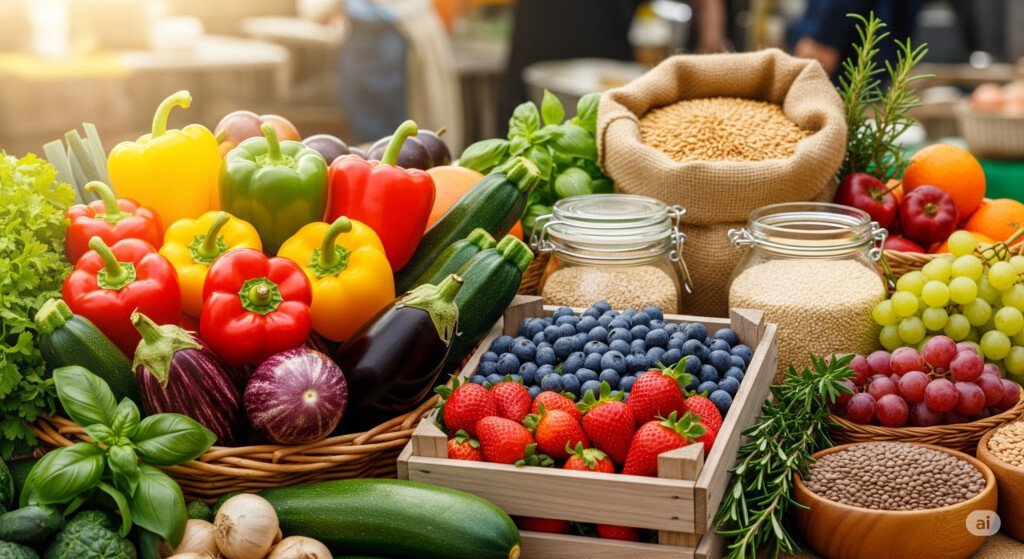

3. Balanced Macros and Portion Control
If there’s one thing that confuses people the most when it comes to sustainable weight loss, it’s the question of macros (protein, carbs, fats) and how much food is “enough.” Some go low-carb, some avoid fats, and others load up on protein shakes without really knowing if it’s working. The truth is, your body needs all three macronutrients in balance—plus a mindful approach to portion sizes—for steady, healthy, and sustainable fat loss.
Let’s break this down step by step.
What Are Macros and Why Do They Matter?
Macronutrients (macros) are the nutrients your body needs in large amounts to function:
- Protein → Builds and repairs muscle, keeps you full, supports fat loss.
- Carbohydrates → Your body’s primary energy source, fuels workouts and daily activity.
- Fats → Essential for hormones, brain function, and absorption of vitamins.
Unlike fad diets that villainize one macro (like low-fat diets in the ’90s or today’s anti-carb trends), a balanced intake is key. Without enough protein, you’ll lose muscle instead of fat. Without healthy carbs, your energy and mood crash. Without good fats, your hormones suffer, making weight loss harder.
The Role of Protein in Weight Loss
If weight loss had a “king macro,” it would be protein. Here’s why:
- Satiety Power – Protein-rich meals keep you fuller for longer, reducing cravings and late-night snacking.
- Muscle Preservation – During a calorie deficit, protein helps prevent muscle loss. The more muscle you keep, the faster your metabolism stays.
- Thermic Effect – Protein burns more calories during digestion (20–30% of protein calories are used just to digest it).
Practical Tip: Aim for about 0.8–1 gram of protein per pound of body weight (or 1.6–2.2g per kg). For example, if you weigh 150 lbs, you’d shoot for around 120–150 grams daily.
Best Sources: chicken, turkey, eggs, fish, Greek yogurt, cottage cheese, lentils, beans, tofu.


The Role of Carbs in Weight Loss
Carbs are often misunderstood. Many crash diets label them as “bad,” but carbs are simply your body’s preferred fuel source. The key is choosing the right type.
- Good (Complex) Carbs: oats, brown rice, quinoa, sweet potatoes, fruits, veggies. These digest slowly, giving sustained energy and stabilizing blood sugar.
- Bad (Refined) Carbs: white bread, pastries, sugary drinks. These spike insulin, leading to energy crashes and fat storage.
Practical Tip: Don’t fear carbs—just be strategic. Eat more carbs around workouts (when your body uses them for fuel) and scale back on inactive days.
The Role of Fats in Weight Loss
Healthy fats are not your enemy—they’re your ally.
- They regulate hormones like testosterone and estrogen (vital for metabolism).
- They keep you full because they digest slowly.
- They support brain health, mood, and nutrient absorption.
Best Sources: avocados, olive oil, nuts, seeds, fatty fish (salmon, sardines), coconut oil in moderation.
Practical Tip: Aim for about 20–30% of your daily calories from healthy fats.
The 40/30/30 Guideline (A Simple Macro Split)
For most people aiming for fat loss and long-term health, a good starting macro ratio is:
- 40% Carbs
- 30% Protein
- 30% Fats
This balance ensures steady energy, lean muscle retention, and hormonal balance. Of course, athletes, sedentary individuals, or those with medical needs may tweak ratios, but 40/30/30 is a safe, sustainable baseline.


Why Portion Control Matters as Much as Macros
Even if you’re eating the “right” foods, portion sizes can make or break your results. A handful of almonds is healthy, but five handfuls add up to 600+ calories quickly.
Portion Control Without Obsessing Over Calories
Not everyone wants to track every bite in MyFitnessPal—and that’s okay. Here are practical strategies:
- The Plate Method:
- ½ plate → vegetables and leafy greens
- ¼ plate → lean protein
- ¼ plate → healthy carbs
- Add → a thumb-sized portion of healthy fat
- Hand Portion Guide:
- Protein → palm-sized portion
- Carbs → cupped hand
- Fats → thumb
- Veggies → fist
This approach is simple, visual, and effective—no scales or calculators needed.
Mindful Eating: The Missing Piece
Portion control isn’t just about measuring food—it’s about listening to your body.
- Eat slowly and stop when you’re 80% full.
- Put down your fork between bites.
- Avoid eating in front of screens, where mindless overeating happens.
- Check in: Are you actually hungry, or just bored/stressed?
Mindful eating aligns your portions with your body’s real needs instead of emotional triggers.
Real-Life Example: Balanced Macros in Action
Imagine two people eating the same calories—2,000 per day.
- Person A eats 2,000 calories of pizza, fries, and soda. Macros are 65% carbs (mostly refined), 25% fat (mostly unhealthy), and 10% protein. They feel sluggish, hungry soon after meals, and struggle to lose fat.
- Person B eats 2,000 calories of lean chicken, veggies, brown rice, avocado, and Greek yogurt. Macros are 40% carbs, 30% protein, 30% healthy fats. They feel satisfied, energized, and lose fat steadily.
👉 Same calories, totally different outcomes. Balanced macros make the difference.
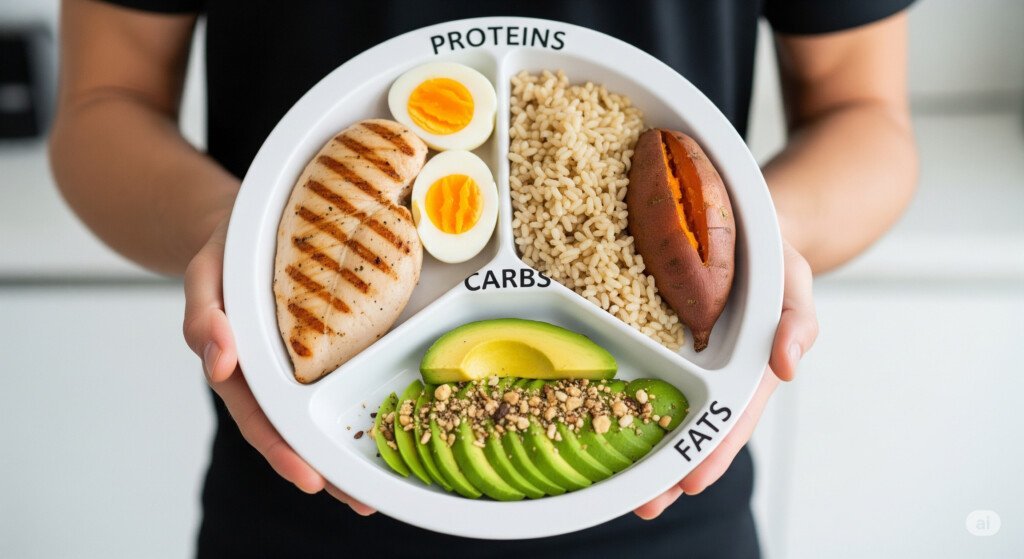

4. Best Diets for Long-Term Weight Loss
When people search for the best weight loss diet, they’re often hoping for a simple, one-size-fits-all solution. But here’s the truth: there isn’t a single “magic” diet that works for everyone. The real key to success lies in finding a way of eating that you can sustain long-term, one that supports your health, fits your lifestyle, and helps you achieve your goals without leaving you feeling deprived.
Let’s break down some of the most proven diet approaches that actually work for sustainable weight loss — not just quick fixes.
1. The Mediterranean Diet: A Gold Standard
The Mediterranean diet is consistently ranked among the healthiest diets in the world. Inspired by the eating patterns of countries like Greece, Spain, and Italy, it emphasizes:
- Whole grains
- Fresh fruits and vegetables
- Olive oil and healthy fats
- Lean proteins like fish and legumes
- Minimal red meat and processed foods
Why it works for weight loss:
The Mediterranean diet isn’t about restriction; it’s about abundance of nutrient-rich foods. Its focus on fiber, healthy fats, and balanced meals naturally reduces overeating and keeps you satisfied longer.
Long-term benefits:
Research links the Mediterranean diet to reduced risk of heart disease, diabetes, and even improved brain health. It’s more than a weight-loss plan — it’s a lifestyle upgrade.
2. The DASH Diet: Heart Health Meets Weight Loss
The DASH diet (Dietary Approaches to Stop Hypertension) was originally designed to lower blood pressure, but it doubles as one of the best diets for weight loss.
It focuses on:
- Reducing sodium
- Prioritizing vegetables, fruits, and whole grains
- Including lean proteins and low-fat dairy
Why it works:
The DASH diet is naturally low in calorie-dense foods like processed snacks and sugary drinks. By cutting excess sodium and processed foods, it helps reduce water retention and bloating while promoting gradual fat loss.
Best for:
People who want to lose weight while protecting their heart and blood pressure.


3. The Flexitarian Diet: Flexible & Plant-Focused
As the name suggests, the Flexitarian diet combines “flexible” and “vegetarian.” It encourages mostly plant-based eating but allows occasional meat and fish.
Why it works:
Plant-based diets are naturally lower in calories and high in fiber, which helps regulate hunger and satiety. Flexitarianism avoids the rigidity of strict vegan or vegetarian diets, making it easier to follow long-term.
Bonus:
This approach is environmentally friendly and associated with lower risks of obesity, diabetes, and certain cancers.
4. Intermittent Fasting: Timing, Not Just Food
Instead of focusing on what you eat, intermittent fasting (IF) focuses on when you eat. Popular methods include:
- 16/8 method (fast 16 hours, eat within an 8-hour window)
- 5:2 method (eat normally 5 days, restrict calories on 2 days)
Why it works for weight loss:
Fasting helps regulate insulin levels and allows your body to tap into fat stores for energy. For many, this creates a natural calorie deficit without counting calories.
Caution:
IF may not be suitable for everyone, especially those with a history of eating disorders or medical conditions. Sustainability depends on whether fasting fits your lifestyle.
5. Low-Carb Diets: The Carb-Control Approach
Low-carb diets (like Keto, Atkins, or moderate carb reduction) limit carbohydrates while increasing protein and healthy fats.
Why they work:
Reducing carbs lowers insulin spikes, which helps the body burn fat more efficiently. High protein intake also boosts satiety, reducing overall calorie intake.
Limitations:
Many people find ultra-low-carb diets difficult to sustain. Carbs are not “bad” — the challenge is choosing the right carbs (whole grains, legumes, fruits) instead of cutting them entirely.
6. Whole30 & Paleo: Short-Term Reset Diets
Diets like Whole30 or Paleo eliminate processed foods, refined sugar, dairy, grains, and legumes for a set period.
Why they work short-term:
Cutting processed foods can lead to quick weight loss and reduced cravings.
But…
They are often too restrictive for long-term sustainability. Most people regain weight once they reintroduce eliminated foods unless they adopt a modified, balanced version.
So, What’s the “Best” Diet for You?
The answer depends on your goals, preferences, and lifestyle:
- Love cultural foods like rice, pasta, or bread? A Mediterranean approach may suit you.
- Want simplicity and plant-based focus? Try Flexitarian.
- Need structure and timing? Intermittent fasting could help.
- Struggle with sugar and cravings? A low-carb approach may give you a reset.
The most effective diet is the one that you can stick to without feeling miserable. Weight loss is not about temporary rules — it’s about finding an approach that feels natural, enjoyable, and sustainable.
Practical Tips for Choosing the Best Diet
- Start Small – Don’t overhaul everything at once. Begin with one or two dietary changes.
- Prioritize Protein – Regardless of diet style, protein helps preserve muscle mass during weight loss.
- Avoid Extremes – Diets that cut out entire food groups rarely last long.
- Listen to Your Body – The best weight loss diet is one that supports your energy, sleep, and overall well-being.
- Think Lifestyle, Not 30 Days – Can you imagine eating this way a year from now? If not, it’s probably not sustainable.


5. Practical Nutrition Tips for Everyday Life
Knowing about healthy eating is one thing — living it daily is another challenge altogether. Between busy schedules, social gatherings, and tempting food ads, sticking to a sustainable nutrition plan can feel overwhelming. That’s why the best strategy is not about perfection but about building small, practical habits that fit into real life.
Here are some proven, realistic tips that make healthy nutrition a natural part of everyday living.
1. Master the Art of Meal Planning
Meal planning is one of the most powerful tools for long-term weight loss. When you plan ahead, you avoid last-minute choices that often lead to unhealthy fast food or processed snacks.
How to start:
- Choose a planning day (usually Sunday) to map out meals for the week.
- Make a grocery list based on those meals to avoid impulse buys.
- Cook in batches: Prepare proteins, grains, and chopped vegetables ahead of time. Store them in containers so you can mix and match during the week.
Pro tip: Start with planning just 3–4 dinners per week instead of the whole week. This feels less overwhelming and still saves time, money, and calories.
2. Grocery Shopping Like a Pro
The way you shop determines how you eat. If your kitchen is stocked with chips, cookies, and soda, resisting temptation becomes a daily battle.
Smart shopping rules:
- Shop the outer aisles (produce, dairy, proteins) — most processed foods hide in the middle.
- Read nutrition labels: Look out for added sugars, sodium, and artificial ingredients.
- Stick to your list to avoid impulse buying.
- Buy frozen fruits & veggies as backups — they’re nutritious, affordable, and convenient.
3. Portion Control Without Obsessing
You don’t have to weigh every bite to manage your portions. Instead, use visual cues:
- Protein: size of your palm
- Carbs: size of your fist
- Fats: size of your thumb
- Veggies: fill half your plate
This method keeps things simple, flexible, and practical — no calorie counting required.
4. Smart Snacking for Energy, Not Empty Calories
Snacking can either derail your weight loss or fuel your success. The difference lies in choosing nutrient-rich snacks that keep you satisfied.
Best snack options:
- Apple slices with almond butter
- Greek yogurt with berries
- A handful of mixed nuts
- Veggie sticks with hummus
- Whole-grain crackers with tuna or boiled eggs
Avoid: chips, cookies, and sugary drinks, which spike blood sugar and leave you hungrier.
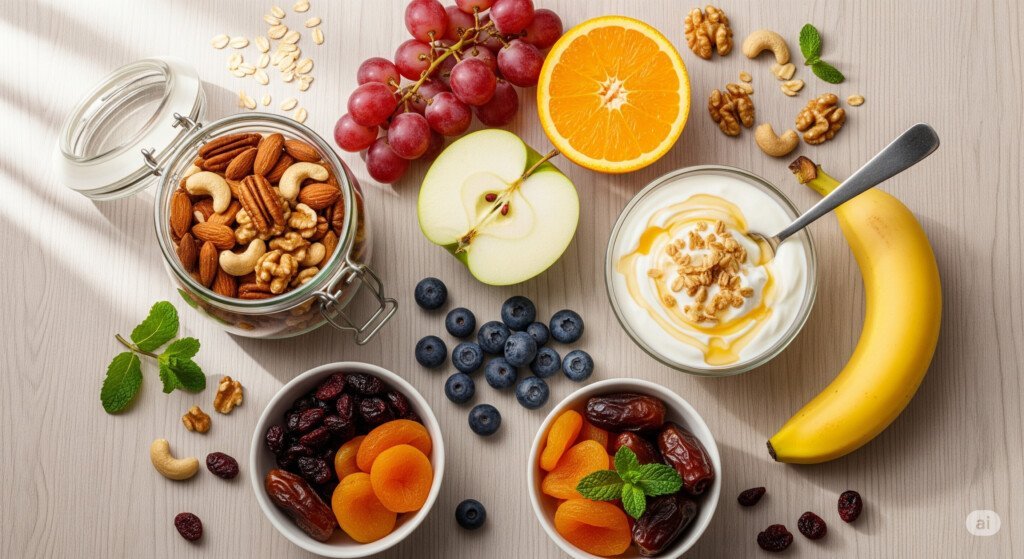

5. Eating Out Without Guilt
Dining out doesn’t have to sabotage your progress. With a few smart strategies, you can enjoy your meals guilt-free.
Tips for eating out:
- Check the menu online ahead of time to make healthier choices.
- Choose grilled, baked, or steamed options instead of fried.
- Ask for sauces/dressings on the side.
- Split large portions with a friend or ask for a to-go box right away.
- Skip the soda — go for water, sparkling water, or unsweetened tea.
Remember: eating out is about enjoyment, not restriction. Balance indulgence with healthy choices.
6. Mindful Eating Over Mindless Eating
Most overeating happens not because of hunger but because of distraction — scrolling on your phone, watching TV, or eating out of boredom.
Mindful eating strategies:
- Sit down at the table without distractions.
- Eat slowly, chewing thoroughly.
- Pay attention to hunger and fullness signals.
- Stop when you feel 80% full, not stuffed.
This simple shift reduces overeating naturally without willpower battles.
7. Hydration: The Forgotten Fat-Loss Tool
Sometimes what feels like hunger is actually thirst. Staying hydrated is one of the easiest, yet most overlooked, nutrition hacks.
Tips:
- Aim for at least 8 glasses of water daily (more if active).
- Carry a reusable water bottle everywhere.
- Flavor your water with lemon, cucumber, or mint if plain water feels boring.
- Drink a glass of water before meals — it helps with portion control.
8. Healthy Swaps That Don’t Feel Like Sacrifice
Small swaps can make a big difference over time without making you feel deprived.
Examples:
- Swap soda → sparkling water with lime
- Swap white bread → whole grain bread
- Swap fried chips → air-popped popcorn or roasted chickpeas
- Swap ice cream → Greek yogurt with fruit
- Swap creamy dressings → olive oil & balsamic vinegar
Over weeks and months, these swaps add up to hundreds of calories saved.
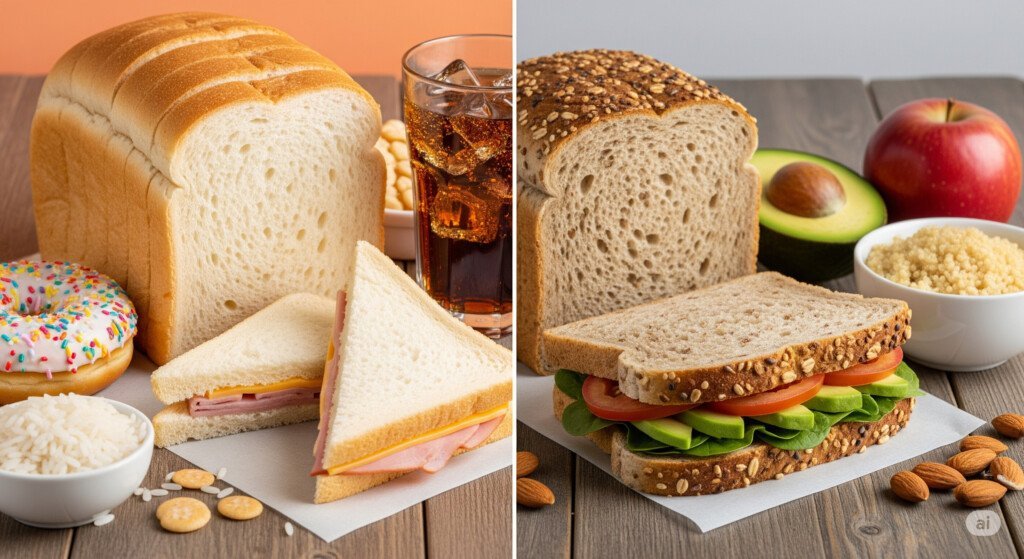

9. The 80/20 Rule: Balance, Not Perfection
A practical approach to nutrition is the 80/20 rule:
- Eat healthy, whole foods 80% of the time.
- Allow room for indulgence 20% of the time (pizza night, birthday cake, etc.).
This prevents the “all-or-nothing” mindset that often leads to binge eating. Remember — consistency beats perfection.
10. Build a Supportive Food Environment
Your environment shapes your habits. If healthy food is visible and accessible, you’re more likely to eat it.
How to design your environment:
- Keep fruit in a bowl on the counter.
- Store cut veggies in clear containers in the fridge.
- Hide or avoid buying junk food altogether.
- Pre-pack healthy snacks for busy days.
This way, the “default” choice is always the healthier one.
11. Create a Meal Routine That Works for You
Some people thrive on three structured meals; others prefer smaller, more frequent meals. There’s no single correct way — the key is consistency.
- If you skip breakfast naturally and don’t feel hungry, intermittent fasting may fit.
- If you get hungry every 3 hours, prepare mini-meals or snacks.
- Track how your energy and mood respond to different patterns, then adjust.
Listen to your body and create a meal rhythm you can stick with.
12. Prepare for “Trigger Situations”
We all face scenarios that test our willpower: late-night cravings, stress eating, or office snacks.
How to manage them:
- Keep healthy alternatives (nuts, fruit, protein bars) nearby.
- Use non-food stress relievers like walking, journaling, or deep breathing.
- Don’t skip meals — skipping often leads to overeating later.
Anticipating challenges makes them easier to manage.


6. Overcoming Emotional Eating & Food Cravings
When people think about weight loss, the focus usually falls on calories, exercise, or diet plans. Yet, one of the biggest challenges doesn’t show up in a food log — it lives in our minds and emotions. Emotional eating and cravings are two of the most common reasons people abandon their health goals. Learning how to manage them is not about willpower alone but about understanding the triggers, building coping strategies, and rewiring habits that keep you stuck.
Why Emotional Eating Happens
Emotional eating is when food becomes a tool for comfort, distraction, or reward rather than nourishment. It’s that moment when stress, loneliness, boredom, or even celebration makes you reach for snacks.
Common emotional triggers include:
- Stress and cortisol: Stress hormones increase appetite and cravings for high-sugar, high-fat foods.
- Loneliness or boredom: Eating provides a temporary sense of comfort or distraction.
- Reward cycles: Growing up, many of us were rewarded with food — like sweets for good grades — creating a lifelong link between food and emotional satisfaction.
- Fatigue: When you’re sleep-deprived, your body craves quick energy, often in the form of sugary or starchy foods.
Understanding these triggers is the first step toward breaking free.
How Cravings Work in the Brain
Cravings aren’t just about lack of discipline. They are biochemical. When you eat processed sugar or highly palatable foods (think chips, cookies, fast food), your brain releases dopamine, the same “feel good” chemical triggered by addictive behaviors. This makes your brain associate those foods with instant relief.
Over time, these cravings become conditioned responses — like automatically wanting chocolate after dinner or soda during work breaks. Recognizing cravings as learned brain responses (not failures) empowers you to re-train those patterns.


Strategies to Handle Emotional Eating
1. Pause & Identify the Trigger
Before reaching for food, pause for 60 seconds and ask:
- Am I actually hungry?
- What am I feeling right now (stress, sadness, boredom)?
- Is food solving this feeling, or is it just a distraction?
Even a short pause can break the automatic cycle.
2. Practice Mindful Eating
Mindful eating means bringing awareness to the experience of food: how it looks, smells, tastes, and how it makes you feel. Eating slowly, chewing thoroughly, and removing distractions (like scrolling on your phone) can prevent overeating and make meals more satisfying.
A practical method is the HALT technique — check if you’re Hungry, Angry, Lonely, or Tired before eating. If it’s not true hunger, address the emotion instead.
3. Create Emotional Coping Alternatives
If emotions are the real trigger, food will never solve it. Build a “comfort toolbox” of alternatives:
- Stress: Practice deep breathing, take a quick walk, or do journaling.
- Boredom: Try a hobby, call a friend, or step outside for fresh air.
- Loneliness: Connect with someone, even a short text or voice note.
- Fatigue: Nap or rest instead of grabbing sugar for fake energy.
The more you replace food with other comforts, the weaker the habit loop becomes.


4. Balance Blood Sugar to Reduce Cravings
Many cravings come from blood sugar spikes and crashes. To stabilize:
- Eat protein and healthy fat at every meal to keep you full.
- Limit refined carbs like white bread and pastries.
- Opt for slow-digesting carbs (oats, quinoa, beans).
- Don’t skip meals — extreme hunger almost always leads to overeating.
When your body is nourished consistently, cravings lose much of their intensity.
5. Use the “Crowding Out” Method
Instead of restricting “bad foods,” fill your meals with so many nutrient-rich options (fruits, vegetables, lean proteins, nuts) that unhealthy foods naturally lose their appeal. When your plate is 80% whole foods, that remaining 20% indulgence won’t derail progress.
6. Redefine Your Relationship with Treats
Cravings don’t have to mean failure. Completely banning certain foods often makes them more tempting. Instead, practice conscious indulgence:
- Plan for a treat once or twice a week.
- Eat it slowly, without guilt.
- Choose quality over quantity — one high-quality dark chocolate square is more satisfying than a whole bag of cheap candy.
This approach removes the “all-or-nothing” mindset that causes binge cycles.
When Emotional Eating Becomes a Deeper Issue
Sometimes, emotional eating can signal deeper challenges like chronic stress, depression, or unresolved trauma. In these cases, professional support from a therapist, nutritionist, or health coach can provide long-term tools for healing. Seeking support is not weakness — it’s strength.
Practical Tips to Beat Cravings in Real Life
- Drink water first: Thirst is often mistaken for hunger.
- Brush your teeth after dinner: Signals “kitchen closed” to your brain.
- Keep trigger foods out of sight: If you must have them, store them in opaque containers or on high shelves.
- Meal prep healthy snacks: Pre-cut fruit, Greek yogurt, hummus, or nuts make smart grab-and-go options.
- Delay tactic: If you crave something, set a timer for 10 minutes and do another activity. Often the craving passes.


7. Building a Sustainable Meal Plan
One of the biggest myths about weight loss is that you need to follow rigid diets with endless restrictions. In reality, the most effective meal plan is one you can stick with long term — flexible, nourishing, and aligned with your lifestyle. A sustainable meal plan doesn’t mean eating chicken and broccoli every day; it means creating balance, variety, and consistency in how you fuel your body.
This section will help you understand how to build a meal plan that fits your unique needs while keeping weight loss enjoyable and sustainable.
The Core Principles of a Sustainable Meal Plan
Before jumping into what to eat, it’s important to set the foundation. A sustainable meal plan should be:
- Balanced – Includes all macronutrients: protein, carbs, and healthy fats.
- Flexible – Allows occasional treats without guilt.
- Personalized – Fits your schedule, culture, preferences, and budget.
- Nutrient-Dense – Prioritizes whole foods over processed alternatives.
- Simple – Easy to prep and repeat without overwhelming effort.
When these principles come together, weight loss becomes a natural byproduct of healthier eating rather than a forced struggle.
1. Calculate Your Calorie & Macro Needs
Every plan begins with knowing how much food your body requires.
- Calories: To lose weight sustainably, aim for a moderate deficit (usually 300–500 calories below maintenance). Extreme deficits often backfire.
- Protein: About 0.8–1g per pound of body weight for muscle preservation and satiety.
- Carbohydrates: 40–50% of daily calories for energy, especially if active.
- Fats: 20–30% of daily calories for hormone balance and brain health.
Instead of obsessing over perfection, use these as guidelines, not rigid rules.
2. Structure Your Meals
Most people thrive on 3 main meals + 1–2 snacks daily. A simple formula for each meal is:
- Protein: Lean meats, fish, eggs, tofu, beans.
- Carbs: Whole grains, fruits, starchy vegetables.
- Fats: Nuts, seeds, avocado, olive oil.
- Fiber + Micronutrients: Vegetables, greens, herbs, spices.
👉 A practical ratio to aim for is:
- ½ plate vegetables
- ¼ plate protein
- ¼ plate carbs
- 1–2 tablespoons healthy fats
This “balanced plate method” works across cultures and cuisines.
3. Build Variety, Not Perfection
One of the top reasons diets fail is boredom. To keep meals sustainable:
- Rotate 2–3 breakfast options you enjoy.
- Batch cook proteins (like chicken, fish, beans) for quick mix-and-match meals.
- Use herbs and spices to make the same ingredients taste different.
- Incorporate cultural comfort foods in healthier ways (e.g., brown rice instead of white, baked instead of fried).
Remember: Consistency > Perfection.


4. Smart Snacking
Snacks are not the enemy — unplanned snacking is. The key is to keep snacks intentional and balanced.
Good snack examples:
- Apple slices with peanut butter
- Greek yogurt with berries
- Hummus with carrot sticks
- A handful of nuts and dark chocolate
These stabilize blood sugar and prevent overeating at main meals.
5. Plan Ahead Without Overcomplicating
Meal prep doesn’t mean spending all Sunday in the kitchen. Sustainable strategies include:
- Cooking double portions for dinner and saving leftovers.
- Pre-chopping vegetables for quick stir-fries or salads.
- Freezing smoothie packs with fruit and greens.
- Using a crockpot or instant pot for set-and-forget meals.
The less effort required in daily decisions, the easier it is to stay consistent.
1-Day Sustainable Meal Plan (1500–1700 Calories)
Here’s a flexible template you can adapt:
Breakfast:
- 2 scrambled eggs with spinach and tomatoes
- 1 slice whole-grain toast with avocado
- 1 cup green tea or coffee (unsweetened)
Snack:
- Greek yogurt with a handful of blueberries and chia seeds
Lunch:
- Grilled chicken breast (4 oz)
- Quinoa (½ cup cooked)
- Steamed broccoli + olive oil drizzle
- Side salad with lemon vinaigrette
Snack (optional):
- Apple + 1 tbsp almond butter
Dinner:
- Baked salmon (4 oz)
- Roasted sweet potato (½ medium)
- Asparagus + garlic sautéed in olive oil
Evening Option (if craving something sweet):
- 1 square of dark chocolate or a small fruit bowl
This template can easily be modified — swap salmon for lentils, chicken for tofu, quinoa for brown rice — keeping the structure while enjoying variety.
Tips for Sticking to Your Meal Plan
- 80/20 rule: Eat nourishing foods 80% of the time, and allow 20% for flexibility.
- Don’t skip meals: Skipping often leads to overeating later.
- Hydrate: Thirst is often mistaken for hunger.
- Mindful indulgence: Plan your favorite foods into your week instead of cutting them out completely.
- Be realistic: If you hate kale, don’t force it. Choose foods you enjoy that align with your goals.
Meal Planning Pitfalls to Avoid
- Over-restriction: Cutting out entire food groups makes diets unsustainable.
- All-or-nothing mindset: One indulgence doesn’t mean you’ve failed.
- Complicated recipes: Stick to simple meals you can prep in under 30 minutes.
- Not adjusting portions: As you lose weight, your calorie needs may change.


8. Common Myths & Mistakes to Avoid in Sustainable Weight Loss
Sustainable weight loss isn’t just about what you do right — it’s also about avoiding the mistakes and misconceptions that derail progress. Many people get caught up in trendy diets, misinformation, or unrealistic expectations, which can lead to frustration and weight regain. In this section, we’ll debunk the most common myths and highlight practical strategies to keep your weight loss journey on track.
1. Carbs Are the Enemy
Carbohydrates have been vilified in many fad diets, but the truth is that not all carbs are created equal.
- Complex carbs (whole grains, vegetables, fruits, legumes) provide slow-releasing energy, fiber, and essential nutrients.
- Simple carbs (sugary drinks, candy, refined flour) can spike blood sugar and promote fat storage when overconsumed.
Mistake to avoid: Completely eliminating carbs. This often leads to fatigue, mood swings, and nutrient deficiencies.
Practical tip: Focus on portion control and whole-food sources. For example:
- Swap white bread for whole-grain bread.
- Replace sugary cereal with oatmeal topped with fruit.
2. All Fats Make You Fat
Fats are essential for hormone production, brain function, and satiety. Cutting them entirely is both unnecessary and counterproductive.
- Healthy fats: avocados, nuts, seeds, olive oil, fatty fish
- Unhealthy fats: trans fats, excessive processed snacks
Mistake to avoid: Over-restricting fats or choosing low-fat products loaded with sugar.
Practical tip: Include a small serving of healthy fat in every meal. Examples:
- 1 tbsp of olive oil on salad
- A small handful of almonds as a snack
Healthy fats actually help you feel full and can prevent overeating later in the day.
3. Skipping Meals Helps You Lose Weight Faster
Skipping meals may seem like an easy shortcut, but it often backfires:
- Can lead to overeating later due to extreme hunger.
- Slows metabolism if done repeatedly.
- Negatively impacts energy, concentration, and mood.
Practical tip: Aim for 3 balanced meals + 1–2 healthy snacks per day. Eating regularly stabilizes blood sugar, maintains energy levels, and supports workout performance.
Internal link opportunity: Refer to cluster blogs like Healthy Snacks for Weight Loss & Meal Prep Ideas for ideas that keep you full without sabotaging progress.


4. “Clean Eating” Means Perfection
The clean eating obsession can cause unnecessary stress or food guilt. No food is inherently “bad,” and balance is key.
Mistake to avoid: Obsessing over perfect food choices or demonizing occasional indulgences. This can lead to:
- Binge episodes
- Negative relationship with food
- Early burnout on the weight loss journey
Practical tip: Adopt a flexible approach:
- Follow the 80/20 rule: 80% nutrient-dense whole foods, 20% indulgences.
- Enjoy treats mindfully without guilt.
This mindset promotes long-term sustainability rather than short-lived perfection.
5. Quick Fixes Work Long-Term
Crash diets, detox teas, or extreme cleanses promise rapid results but rarely deliver lasting outcomes.
Why they fail:
- They often involve unsustainable calorie restriction.
- Can cause muscle loss, nutrient deficiencies, and metabolic slowdown.
- Most people regain weight once they return to normal eating.
Practical tip: Focus on gradual, consistent changes:
- Swap sugary drinks for water or herbal tea.
- Add vegetables to every meal.
- Commit to moderate exercise consistently.
Sustainable changes create lifelong habits rather than temporary results.
6. Exercise Alone Is Enough
While exercise is essential, it cannot fully compensate for poor dietary choices. Many overestimate calories burned during workouts.
Mistake to avoid: Relying solely on exercise while neglecting nutrition.
Practical tip: Combine balanced nutrition + exercise for the best results. For instance:
- Pair strength training with high-protein meals for muscle growth.
- Use cardio sessions to complement portion-controlled meals.
Keyword focus: Healthy weight loss tips (KD ≤40) — exercise should enhance, not replace, mindful eating habits.
7. Weight Loss Should Be Rapid
Expecting fast results sets unrealistic standards and increases frustration. Healthy, sustainable weight loss is typically 0.5–1 kg (1–2 lbs) per week.
Mistake to avoid: Drastic dieting or overtraining to force rapid results.
Practical tip: Track non-scale victories:
- Increased energy
- Better sleep
- Clothes fitting differently
- Strength improvements
These indicators often reflect more meaningful progress than the scale alone.
How to Correct These Mistakes
- Educate Yourself: Learn about balanced nutrition and realistic expectations.
- Plan Ahead: Meal prep, snack prep, and structured workouts prevent reactive choices.
- Track Progress Smartly: Use journals, photos, or habit trackers instead of obsessing over daily scale numbers.
- Be Flexible: Life happens. Adapt and return to habits without guilt.
- Seek Support: Accountability partners, coaches, or online communities help reinforce sustainable habits.
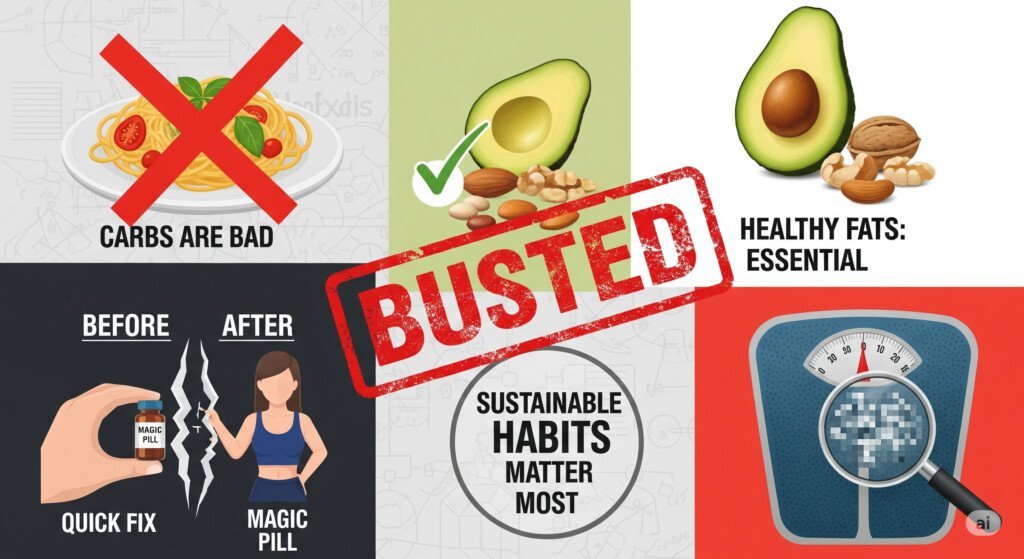

5. Exercise for Sustainable Weight Loss
When it comes to sustainable weight loss, exercise is often misunderstood. Many people assume that more hours in the gym automatically lead to faster results, or that only cardio matters. In reality, exercise is a tool to complement nutrition and mindset, and the right approach focuses on consistency, variety, and gradual progress. In this section, we’ll explore the different forms of exercise, simple routines for beginners, and why consistency beats intensity every time.
1. Why Exercise Matters
Exercise doesn’t just burn calories — it plays a critical role in:
- Preserving muscle mass: During weight loss, maintaining lean muscle helps keep your metabolism active.
- Improving cardiovascular health: Heart health, circulation, and lung capacity improve even with moderate exercise.
- Enhancing mood and energy: Movement triggers endorphins and helps regulate stress hormones, which often influence food choices.
- Supporting long-term adherence: People who combine exercise with nutrition are more likely to maintain weight loss.
2. Strength Training vs Cardio
Both strength training and cardio have unique benefits for sustainable weight loss:
Strength Training (Resistance Training)
- What it is: Weight lifting, bodyweight exercises, resistance bands, or machines.
- Why it works: Builds lean muscle, which increases resting metabolism and burns more calories even at rest.
- Examples: Squats, push-ups, lunges, dumbbell rows, planks.
Tip for beginners: Start with 2–3 sessions per week, focusing on full-body workouts. Begin with bodyweight exercises if equipment is unavailable.
Cardio (Aerobic Exercise)
- What it is: Continuous movement that raises heart rate — running, brisk walking, cycling, swimming.
- Why it works: Burns calories during the activity and improves cardiovascular fitness.
- Examples: Walking, jogging, cycling, group classes, swimming laps.
Tip for beginners: Begin with 20–30 minutes per session, 3–4 times a week. Walking is highly effective and low-impact.


3. Combining Strength & Cardio
For the best results, a balanced routine includes both:
- Strength training 2–3 days per week to preserve muscle and boost metabolism.
- Cardio 3–5 days per week to increase calorie burn and heart health.
- Optional: High-Intensity Interval Training (HIIT) 1–2 days per week for efficiency and calorie burn.
Practical tip: Start simple — 20–30 minutes of walking plus two 20–30 minute strength sessions per week. Gradually increase duration and intensity.
4. Simple Routines for Beginners
You don’t need a gym membership to start:
Beginner Strength Routine (Bodyweight, 2–3x per week)
- Squats – 3 sets of 10–15 reps
- Push-ups (knee or standard) – 3 sets of 8–12 reps
- Glute bridges – 3 sets of 12–15 reps
- Plank – 3 sets of 20–40 seconds
- Supermans (for lower back) – 3 sets of 10–12 reps
Beginner Cardio Routine (20–30 min, 3–4x per week)
- Brisk walking around your neighborhood
- Jog/walk intervals (1 min jogging, 2 min walking)
- Cycling or stationary bike
- Dancing or home cardio videos
Pro tip: Track progress in minutes, reps, or distance rather than focusing solely on weight loss. This keeps motivation high.


5. Importance of Consistency Over Intensity
Many beginners make the mistake of pushing too hard initially, which leads to burnout or injury. Sustainable exercise focuses on regular, manageable movement:
- Short, daily sessions are often more effective than sporadic high-intensity workouts.
- Gradually increasing duration, frequency, or intensity prevents plateaus.
- Mindset matters — view exercise as a habit rather than punishment.
Example: Walking 30 minutes every day plus two strength sessions per week is far more effective long-term than 3 hours of high-intensity exercise once a week.
6. Integrating Exercise Into Daily Life
Exercise doesn’t always require formal gym sessions:
- Take the stairs instead of the elevator.
- Walk or cycle for short errands.
- Stretch or do bodyweight exercises during TV breaks.
- Use resistance bands at home for quick strength routines.
Even small bursts of activity contribute to calorie burn and help develop consistency.
7. Tips for Staying Motivated
- Set realistic goals: Focus on consistency rather than speed of results.
- Track your progress: Use a journal, app, or photos.
- Find enjoyable activities: Dancing, swimming, hiking, or sports — exercise shouldn’t feel like punishment.
- Workout with a friend or community: Social accountability improves adherence.
- Celebrate non-scale victories: Better sleep, mood, strength, and energy are key indicators of progress.


6. Foods That Support Weight Loss
When it comes to sustainable weight loss, what you eat is just as important as how you move. Certain foods naturally support fat loss, boost metabolism, and help you feel full longer, making it easier to stick to a calorie-controlled diet. In this section, we’ll explore the best weight loss foods, hydration strategies, and metabolism-boosting tips to help you create a practical, long-term eating plan.
1. High-Protein Foods for Satiety and Muscle Maintenance
Protein is the cornerstone of sustainable weight loss for several reasons:
- Keeps you full longer: Protein takes longer to digest than carbs, reducing hunger pangs.
- Preserves lean muscle: During weight loss, protein helps maintain muscle mass, which keeps your metabolism active.
- Boosts calorie burn: Digesting protein burns more energy than carbs or fats, a phenomenon known as the thermic effect of food.
Examples of high-protein foods:
- Eggs and egg whites
- Greek yogurt and cottage cheese
- Chicken, turkey, lean beef, and fish
- Plant-based options: lentils, chickpeas, tofu, tempeh, edamame
- Protein powders (whey, pea, or soy) for convenient supplementation
Tip: Include protein in every meal and snack to stabilize blood sugar and reduce cravings.
2. Fat-Burning Fruits and Vegetables
Fruits and vegetables are essential for weight loss because they’re low in calories but high in fiber, vitamins, and minerals. Fiber slows digestion, improves satiety, and supports gut health, all of which are critical for fat loss.
Top fat-burning or metabolism-supporting fruits:
- Berries (blueberries, strawberries, raspberries) – high in antioxidants and fiber
- Grapefruit – may help regulate insulin levels and control appetite
- Apples and pears – fiber-rich for fullness
Top fat-burning or metabolism-supporting vegetables:
- Leafy greens (spinach, kale, romaine) – low-calorie, nutrient-dense
- Cruciferous veggies (broccoli, cauliflower, Brussels sprouts) – high in fiber, support digestion
- Peppers, zucchini, cucumber – low-calorie fillers for meals
Tip: Make half your plate vegetables at every meal. Use fruits as snacks or dessert replacements to satisfy sweet cravings without added sugar.


3. Healthy Fats That Aid Weight Loss
Not all fats are bad. Healthy fats can promote satiety, stabilize blood sugar, and support hormone function.
Good sources of healthy fats:
- Avocado
- Nuts (almonds, walnuts, pistachios)
- Seeds (chia, flax, pumpkin, sunflower)
- Olive oil and coconut oil
- Fatty fish (salmon, mackerel, sardines)
Tip: Include a small portion of healthy fats at meals, but avoid excess — 1–2 servings per day is enough.
4. Hydration and Metabolism Boosters
Water is often overlooked, but it plays a crucial role in weight loss:
- Supports digestion and nutrient absorption
- Increases calorie burn slightly via thermogenesis
- Reduces hunger when consumed before meals
Tips for staying hydrated:
- Drink a glass of water 20–30 minutes before meals to prevent overeating
- Herbal teas like green tea and hibiscus can mildly boost metabolism
- Limit sugary drinks and sodas, which add empty calories
Other metabolism boosters:
- Spices like cayenne pepper, cinnamon, and turmeric
- Coffee or green tea in moderation (avoid sugar)
5. Practical Ways to Incorporate Weight Loss Foods
Meal prep ideas:
- Breakfast: Greek yogurt parfait with berries and chia seeds
- Lunch: Grilled chicken salad with mixed greens, peppers, and olive oil dressing
- Snack: Apple slices with almond butter
- Dinner: Baked salmon with steamed broccoli and quinoa
Smart swaps for sustainable eating:
- Replace sugary drinks with infused water or herbal tea
- Swap white rice for cauliflower rice or quinoa
- Replace processed snacks with fruit, nuts, or roasted chickpeas
Tip: Focus on whole foods, fiber, and protein as the foundation of every meal. Over time, these habits make calorie control effortless.
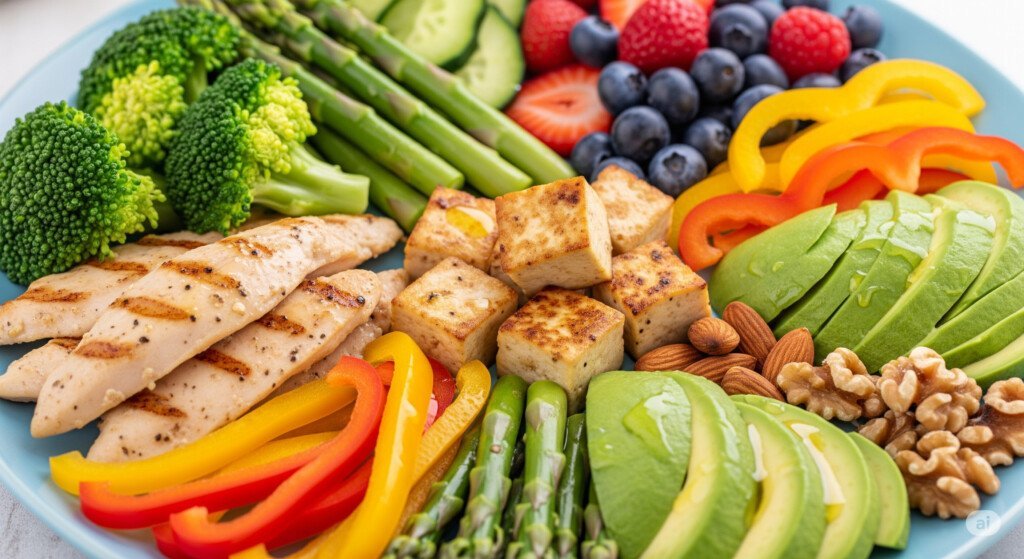

7. Building the Right Mindset
Sustainable weight loss is not just about food and exercise—it’s equally about your mindset. Without the right mental framework, even the most meticulously planned diet or exercise routine can fall apart. This section dives deep into building weight loss motivation, overcoming emotional eating, and understanding the psychology behind long-term success.
1. Understanding Motivation and Its Role in Weight Loss
Motivation is the driving force that keeps you consistent with your habits. However, it’s normal for motivation to fluctuate. Recognizing this can prevent frustration and burnout.
- Intrinsic motivation: Driven by personal values, health goals, or desire for self-improvement. For example, wanting more energy to play with your kids or improving your overall health.
- Extrinsic motivation: Driven by external factors, such as compliments, social recognition, or events like a wedding. While helpful initially, it’s less sustainable long-term.
Tip: Focus on building intrinsic motivation. Ask yourself daily why you want to lose weight and how it will positively impact your life. Write it down and revisit it whenever motivation dips.
2. Overcoming Motivation Dips
Even the most determined individuals experience moments of low motivation. Here’s how to navigate them:
- Set micro-goals: Break your weight loss journey into weekly or monthly targets rather than focusing only on long-term results. Small wins reinforce consistency.
- Track progress visually: Use photos, measurements, or a simple calendar checkmark system to see tangible evidence of progress.
- Create accountability: Share your journey with a friend, join a support group, or track online. Accountability increases adherence.
- Reward wisely: Celebrate non-food achievements, like completing a week of workouts or meal-prepping consistently.
3. Handling Cravings and Emotional Eating
Emotional eating is one of the most common obstacles in weight loss. Many people turn to food for comfort, stress relief, or boredom. Recognizing the triggers is the first step toward control.
Common triggers:
- Stress and anxiety
- Sadness or loneliness
- Social events or peer influence
- Fatigue and sleep deprivation
Strategies to manage emotional eating:
- Pause and reflect: Before reaching for food, take a 5-minute pause to assess hunger vs emotion.
- Find alternatives: Journaling, walking, meditating, or chatting with a friend can replace the urge to snack.
- Mindful eating: Eat slowly, savor each bite, and avoid distractions like TV or smartphones. This helps recognize satiety cues.
- Plan ahead: Keep healthy snacks on hand and avoid buying trigger foods.
4. Psychology Behind Long-Term Weight Loss Success
Successful, sustainable weight loss is often more mental than physical. Studies show that people who maintain weight loss long-term adopt specific psychological strategies:
- Habit formation over willpower: Relying solely on willpower is unsustainable. Instead, create routines—like prepping meals on Sundays or exercising at the same time each day—to make healthy choices automatic.
- Cognitive restructuring: Replace negative self-talk (“I’ll never lose weight”) with empowering thoughts (“I am capable of achieving my goals with consistent effort”).
- Flexibility mindset: Life is unpredictable. One indulgent meal or skipped workout isn’t failure—it’s an opportunity to refocus.
- Self-monitoring: Regularly track habits, moods, and triggers. Awareness is a powerful tool to prevent slipping into old patterns.
5. Strategies for Maintaining Long-Term Motivation
- Visualize your goals: Picture the benefits of your weight loss journey—better health, increased energy, improved confidence.
- Focus on process, not perfection: Celebrate consistency in eating well, exercising, and self-care, rather than obsessing over the scale.
- Build a support network: Surround yourself with positive influences who encourage your goals. Online communities or local groups can be powerful motivators.
- Reassess regularly: Adjust goals, habits, and routines as your lifestyle evolves to avoid plateauing or losing interest.


8. Common Mistakes to Avoid
Sustainable weight loss requires patience, planning, and consistency. Yet many people unknowingly sabotage their progress with common mistakes. Understanding these pitfalls can save you months of frustration and help you stay on track toward long-term success.
1. Crash Diets and Extreme Restrictions
One of the biggest weight loss mistakes is turning to crash diets or extreme restrictions. These diets promise rapid results but often fail in the long term.
Why they backfire:
- Metabolic slowdown: Severe calorie restriction signals the body to conserve energy, slowing your metabolism and making fat loss harder.
- Muscle loss: Losing lean muscle along with fat reduces strength, energy, and metabolic rate.
- Nutrient deficiencies: Extreme diets often lack essential vitamins, minerals, and macronutrients, leading to fatigue, hair loss, and other health issues.
- Yo-yo effect: Rapid loss is often followed by equally rapid gain once normal eating resumes.
Better approach:
- Focus on a moderate calorie deficit paired with nutrient-dense foods.
- Prioritize sustainable habits over “quick wins.”
2. Overtraining and Ignoring Rest
Another mistake is believing that more exercise automatically equals faster weight loss. Overtraining without proper rest can harm your progress.
Risks of overtraining:
- Increased risk of injuries and muscle strains
- Hormonal imbalances, including elevated cortisol
- Mental burnout and reduced motivation
- Sleep disturbances, which can negatively affect weight loss
Best practices:
- Incorporate rest days and active recovery (like walking or gentle yoga).
- Combine strength training and cardio for balanced results.
- Listen to your body—pain and fatigue are signals to slow down, not push harder.
3. Under-Eating and Skipping Meals
Skipping meals or under-eating in an attempt to lose weight faster is counterproductive.
Why it doesn’t work:
- Triggers extreme hunger, leading to binge eating later.
- Reduces energy for workouts and daily activities.
- Can negatively affect hormonal balance, particularly ghrelin (hunger hormone) and leptin (satiety hormone).
Better approach:
- Eat balanced meals with adequate protein, fiber, and healthy fats.
- Include snacks if needed to maintain energy levels.
- Focus on consistency and nutrient density rather than drastic calorie cuts.
4. Setting Unrealistic Goals
Many people fail because they aim for rapid, dramatic results rather than realistic, incremental progress.
Problems with unrealistic goals:
- Leads to disappointment and reduced motivation
- Increases the likelihood of abandoning healthy habits
- Encourages unsustainable methods (like crash diets or overtraining)
How to set realistic goals:
- Aim for 1–2 pounds of weight loss per week, which is safe and sustainable.
- Focus on habit-based goals, such as completing workouts consistently or increasing daily steps.
- Celebrate non-scale victories, like improved stamina, better sleep, or clothes fitting more comfortably.


5. Ignoring Mindset and Emotional Eating
Weight loss is as much mental as physical. Ignoring psychological factors is a common mistake.
Examples:
- Using food as a reward or coping mechanism
- Letting temporary setbacks derail your progress
- Obsessing over the scale rather than habits
Solutions:
- Practice mindful eating and recognize emotional triggers.
- Build a support system of friends, family, or online communities.
- Focus on consistency and long-term habits, not perfection.
6. Relying Solely on Supplements or “Quick Fixes”
Many people fall for weight loss supplements or gimmicks promising fast results. While some supplements can support your journey, they cannot replace real food, exercise, and habits.
Risks of over-reliance:
- Wasting money on ineffective products
- Ignoring fundamental nutrition and lifestyle changes
- Potential side effects from unregulated products
Better approach:
- Prioritize whole foods for vitamins, minerals, and protein.
- Use supplements only when evidence-backed and recommended by a healthcare professional.


10. Conclusion & Next Steps
Sustainable weight loss is not about fleeting trends, miracle pills, or punishing exercise routines. It’s about creating a balanced lifestyle that nourishes your body, strengthens your mind, and fits seamlessly into your daily life. Over the course of this guide, we’ve explored nutrition, exercise, mindset, and common pitfalls, all aimed at helping you lose weight safely and keep it off.
1. Recap: The Sustainable Approach
Let’s revisit the core principles:
- Balanced Nutrition: Focus on whole foods, proper portion sizes, and balanced macros. Avoid extreme restrictions that compromise your health or metabolism. Meal prepping and smart swaps make it easier to stick to your diet without feeling deprived.
- Consistent Exercise: Regular movement, combining strength training and cardio, supports fat loss, improves energy, and preserves muscle mass. Consistency is far more effective than sporadic high-intensity workouts.
- Mindset & Motivation: Weight loss is as mental as it is physical. Building resilience against emotional eating, handling cravings, and celebrating non-scale victories ensures that you don’t lose momentum during challenging times.
- Avoiding Common Mistakes: Crash diets, overtraining, skipping meals, unrealistic goals, and over-reliance on supplements often derail progress. Awareness and prevention of these pitfalls are essential for long-term success.
- Smart Food Choices: Prioritize high-protein foods, fat-burning fruits, vegetables, and hydration to support metabolism, satiety, and overall health.
By integrating these elements, you’re not chasing short-term results. Instead, you’re creating a lifestyle that supports weight loss, well-being, and energy for years to come.
2. Next Steps: Putting It into Action
Understanding the principles is one thing; applying them consistently is where transformation happens. Here’s a roadmap to get started today:
- Audit Your Current Habits: Keep a food and activity journal for a week. Identify areas where you can improve without drastic changes.
- Set Achievable Goals: Aim for 1–2 pounds of weight loss per week. Focus on habit-based targets like adding daily walks or cooking more meals at home.
- Create a Meal & Exercise Plan: Combine balanced meals, proper portion sizes, and enjoyable workouts. Remember, flexibility is key—your plan should fit your lifestyle, not the other way around.
- Build Accountability: Partner with a friend, join an online group, or use apps to track progress. Accountability improves adherence and motivation.
- Prioritize Mindset & Recovery: Celebrate small wins, practice mindful eating, and ensure adequate sleep. These are often overlooked yet crucial for sustainable weight loss.
- Review & Adjust: Every 2–4 weeks, reassess your habits, meals, and workouts. Make small tweaks to continue improving without feeling overwhelmed.


3. Explore More Resources
To continue your journey, dive deeper into specific areas of sustainable weight loss:
- Nutrition: Discover practical meal prep strategies, snack ideas, and macro-balanced recipes.
- Exercise: Find beginner-friendly routines, HIIT plans, and cardio strategies tailored to your goals.
- Mindset: Strengthen motivation, manage cravings, and overcome emotional eating. (
- Common Mistakes: Learn how to avoid pitfalls that commonly derail progress.
By exploring these resources, you’ll equip yourself with actionable tips, science-backed strategies, and motivation, ensuring that your weight loss journey is both effective and sustainable.
4. Final Thoughts
Sustainable weight loss is a journey, not a sprint. Quick fixes may provide temporary results, but lasting transformation comes from consistency, patience, and balance. By combining the right nutrition, exercise, mindset, and avoidance of common mistakes, you’re creating a foundation that not only helps you shed pounds but also improves your overall health, energy levels, and quality of life.
Remember, the goal isn’t just to lose weight; it’s to gain a healthier, more vibrant life. Every small choice you make—choosing whole foods, going for a walk, drinking enough water, or practicing mindful eating—adds up over time. Sustainable weight loss is achievable for anyone who is willing to embrace these principles with patience and commitment.
FAQ
1. What is sustainable weight loss and how is it different from quick fixes?
Sustainable weight loss focuses on gradual, healthy fat loss through a balanced approach involving nutrition, exercise, and mindset. Unlike fad diets or extreme restrictions that promise rapid results, sustainable weight loss aims to maintain results long-term without compromising health. Quick fixes may lead to temporary weight loss, but most people regain it quickly due to muscle loss, nutrient deficiencies, and unsustainable habits.
2. How can I lose weight naturally without supplements or extreme diets?
Losing weight naturally involves creating a safe calorie deficit while eating nutrient-dense whole foods, staying physically active, and practicing mindful habits. Focus on balanced macros, portion control, and regular movement rather than relying on pills, shakes, or detoxes. Small, consistent changes often yield long-term results.
3. What is the best diet for long-term weight loss?
The best weight loss diet is flexible, balanced, and sustainable. Diets like Mediterranean, DASH, and flexitarian emphasize whole foods, lean protein, healthy fats, and complex carbs. Meal prep, smart swaps, and consistency matter more than following a rigid plan. Avoid diets that eliminate entire food groups or drastically reduce calories, as they are usually unsustainable.
4. How often should I exercise for sustainable weight loss?
Consistency matters more than intensity. Aim for 150–300 minutes of moderate exercise per week, combining strength training and cardio. Beginners can start with 20–30 minutes daily, gradually increasing intensity. Strength training preserves muscle mass, while cardio supports calorie burn and cardiovascular health.
5. Which foods support weight loss naturally?
High-protein foods (chicken, fish, legumes), fat-burning fruits (berries, grapefruit), fiber-rich vegetables, and hydration boosters like water and green tea all support metabolism and satiety. Avoid ultra-processed foods and sugary beverages that trigger cravings and hinder fat loss.
6. How do I stay motivated during my weight loss journey?
Weight loss motivation comes from setting realistic, measurable goals, tracking progress, and celebrating small victories. Mindset practices like journaling, mindful eating, and visualizing your progress help overcome dips in motivation. Surrounding yourself with a supportive community can also enhance accountability.
7. What are the most common mistakes people make while losing weight?
Common mistakes include crash dieting, skipping meals, overtraining, unrealistic goal-setting, and ignoring recovery. These habits often lead to burnout, nutrient deficiencies, and weight regain. Instead, focus on gradual progress, balanced nutrition, and consistent movement.
8. How can I overcome emotional eating and cravings?
Emotional eating is triggered by stress, boredom, or habits rather than true hunger. Strategies include mindful eating, identifying triggers, keeping healthy snacks handy, and practicing stress-relief techniques like meditation or walking. Building awareness and replacing emotional triggers with healthier coping strategies can help prevent overeating.
9. How do I create a sustainable meal plan for weight loss?
A sustainable meal plan balances protein, carbs, and fats, includes plenty of vegetables, and fits your lifestyle. Meal prep for the week, plan snacks, and allow flexibility to prevent burnout. Tracking portions, rotating foods, and including favorite meals in moderation ensures long-term adherence.
10. How long does it take to see results with sustainable weight loss?
Results vary by individual, but a safe, sustainable rate is 1–2 pounds per week. Significant visible changes often appear within 4–12 weeks, depending on consistency, diet quality, and activity levels. The key is focusing on habit-building, not quick fixes, for lasting transformation.
Disclaimer:
This post may contain affiliate links. If you purchase through them, we may earn a small commission at no extra cost to you. Also, this content is for informational purposes only and does not substitute professional medical advice.


